|
YES IT IS ALL ABOUT THE BIRDS!!!.
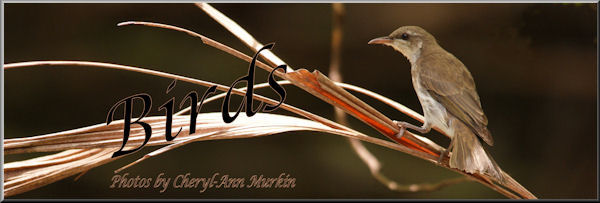
BIRDS FROM MY OWN BACKYARD: ABOVE & BEYOND:
I cannot post any photos for a little while as my DVD RW Drive is totally buggered and we need to replace this little laptop. I have been using another computer to store our photos on and moving them by disc to this laptop, but unfortunately this is no longer happening.... *****7 x White-throated Needletails heading S at 7:09am. Went back outside at 8:00am and saw 3 more heading same direction at 8:11am.*****Finally got some photos of the Collared Sparrowhawk yesterday Saturday 13 June, 2015!. Not the greatest but a start!. Please Scroll down to see them.
*****Just had a great show from a mixed 'flock' of hundreds of White-browed and Masked Woodswallows, which started close to 10:00am this morning (Sunday, 31 May, 2015), they were everywhere!. There were also other Woodswallows present, not certain what species, but certain that there were smaller numbers of Little Woodswallows amongst them. Just prior to the woodswallows arrival there were two White-bellied Sea Eagles and a Brown Falcon soaring with a couple of flocks of Pelicans. I went out to try to get some photos of a Black-chinned Honeyeater, and got this great show!. Unfortunately my camera is playing up big time so missed out on some great shots. Managed to capture a few 'crappy' photos of a few of the woodswallows and the Sea-Eagles which I have posted on RECENT BIRD SIGHTINGS page.
Please be aware that the following bird orders/families/individual species may not be strictly in taxonomical order, I'm just listing those which are represented in photographs I have taken, and will add more as time goes on. Having over 25 - 30 thousand photos and adding more all the time it's difficult to keep up.
The majority of images are of wild birds taken in or from my own backyard, unless specified as "captive", or taken from another area. We are so lucky that our acreage property is on a flight path to all surrounding wetlands such as the Town Common to the north, Cromarty Wetlands and various Lagoons (Horseshoe, Pink Lily, etc) to the south and west, rivers, East/ESE to Ross River dam, etc.
All images posted on my website are small low resolution files not suitable for printing. I keep all Original un-cropped high resolution images.
All images are Copyright. Please do not use images for any purpose including website use or derivative works, Including mirror Images without express written permission from the Artist/Copyright holder.
MY BACKYARD BIRDLIST: Resident, visitors & flyovers; including unusual sightings following weather events such as cyclones: (there are other species as well, but can't list them here until I can positively ID them by photograph).
Magpie Goose - flyovers. Individuals to flocks. Larger flocks in early years.
Plumed Whistling-duck.
Wandering Whistling-duck.
White-headed Pigeon.
Crested Pigeon.
Squatter Pigeon - last sighting was 2 birds 'squatting' on the grassy road verge near high transmission lines heading West - nearer to Hammond Way 2014 - Kelso Drive, later months of 2014 - didn't record the date. I dont get out much these days!!!.
Peaceful Dove.
Bar-shouldered Dove.
Wompoo Fruit-dove.
Pied Imperial Pigeon.
Topknot Pigeon.
Tawny Frogmouth.
White-throated Needletail - mostly with Fork-tailed Swifts, although see occasional individuals.
Fork-tailed Swift - hawking flocks.
Australasian Darter - flyovers.
Great (Black) Cormorant - flyovers.
Australian Pelican - flyovers.
White-necked Heron - flyovers.
Eastern Great Egret - flyover, drop in, earlier visitor to pond.
Intermediate Egret - as for EGE.
Cattle Egret - earlier visitor to pond, always flying over. Larger numbers since storms earlier this year. 11 April, 2015 - approx. 200+ within a 10 minute period heading north. Not counting movements south, or others during the day. Grey Goshawk - 5.50pm, Pacific Baza in yard am.
White-faced Heron.
Nankeen Night Heron- regular visitors, including immatures.
Glossy Ibis - haven't seen on our property for many years.
Australian White Ibis- have taken up residence. Started with a pair, and baby makes 3; to 5 in our pond on Saturday 9 May, 2015!!...3 squatting on the small island, 1 on the bridge and 1 having a swim. Luckily only 3 have stayed on!.
Straw-necked Ibis - come in the yard rarely these days don't like the jungle now, but saw 3 on our property late 2014. These guys have been hanging around lately, low flying flocks and individuals, including our yard. Usually you see flocks of these guys soaring on thermals.
Royal Spoonbill - early years of our pond (small lagoon) - flyovers.
Yellow-billed Spoonbill - early years of our pond.
Eastern Osprey.
Black-shouldered Kite.
Square-tailed Kite.
Pacific Baza - see them almost daily throughout the year, but are nesting now.
2 x Pacific Bazas in flight - 1 May, 2015 @ 9:42:16am. Wedge-tailed Eagle at 9:46:03am. 2 x Pacific Bazas in yard yesterday morning Monday, 11 May, 2015. The nearest just 6-7m from our back door.
White-bellied Sea Eagle.
Whistling Kite.
Brahminy Kite.
Black Kite.
Brown Goshawk - have been seeing a male and female for several weeks. (May 10, 2015). Also one Immature/Juvenile. Have some photos - not the greatest - from 5 & 6 May of adults soaring high up.
Collared Sparrowhawk - now have 3 (two adults and 1 immature) harassing all the small birds in the area.
- May 3, Male 2015 - flying lower down in our backyard, no photo due to trees.
Grey Goshawk - last sighting - Saturday, 11 April, flew over the top of me - low light - 5:50pm, haven't seen one since late 2014, where I saw one 3 days in a row (Grey morph).
Spotted Harrier - Latest sightings: 31 January 2015/1 February 2015 - 10:30am approx.; 7 April, 2015. Will have to check notes. Drainage easement - Rural Residential area - a good place to look for Spotted Harriers when you cant find them anywhere else!. (Updated - Friday 22 May, 2015). Have also seen them on the river side of Riverway Drive closer to Thuringowa Central.
Swamp Harrier.
Australian Hobby. Australian (Nankeen) Kestrel.
Peregrine Falcon.
Wedge-tailed Eagle - always had Wedgies in the area. Have been seeing two Wedge-tailed Eagles for ages. 1 April, 2014 - 2 x Wedgies; May 15 - 2015 - two Wedgies 3:51:16pm. Not counting single bird sightings.
Brown Falcon. Now regular visitor flying low in our property.
Brolga - flyovers. Latest - 2 x 6 May 12:44:36pm. Soaring up high.
Purple Swamphen.
Pale-vented Bush-hen -
***visit every year to breed. Had one sighting this year (2015), can't remember what date and have heard them on two other occasions, including Sunday morning.
Bush Stone Curlew - hear them most nights, but sadly not as many around these days, it sounded like Maggie Island here for many years.
Masked Lapwing - these guys just dont quit!!.
Comb-crested Jacana - early years.
Red-tailed Black Cockatoo - common here - have been raiding our Terminalias the last couple of weeks. (April). Still visiting - May 2015.
Galah.
Little Corella.
Sulphur-crested Cockatoo.
Rainbow Lorikeet - flock of 200+ seen Saturday 11 April, 2015.
Scaly-breasted Lorikeet.
Little Lorikeet.
Double-eyed Fig-Parrot. Haven't seen them for 2 years approx.
Australian King Parrot - earlier years.
Red-winged Parrot-
very common here. Saw over 50 Red-winged Parrots in two 'feeding' flocks (one of around 40) smaller flock following)- late this afternoon (29/04/15).
30 April - 48. May - 14-15 in our yard at a time.
Pale-headed Rosella.
Budgerigar -
Over the many years since we have lived here have seen occasional flocks of Budgies moving through our area. During drought periods out west they tend to move eastwards towards the coast ...to "greener pastures".
**Latest sighting, (didn't write it down) was either Wednesday 6 May, Thursday 7 May, Friday 8 May - fast moving tight small flock - conservative estimate of at least 50 or more (probably double or triple that number in reality) coming from south heading NW at first then to the North.
Pheasant Coucal.
Eastern Koel.
Channel-billed Cuckoo.
Horsfield's Bronze Cuckoo.
Black-eared Cuckoo.
Shining Bronze Cuckoo.
Pallid Cuckoo.
Fan-tailed Cuckoo.
Brush Cuckoo.
Oriental Cuckoo.
Southern Boobook. Barking Owl.
Laughing Kookaburra.
Blue-winged Kookaburra.
Various Kingfishers- haven't seen many for years.
Forest Kingfisher.
Sacred Kingfisher - most common these days.
Rainbow Bee-eater - common.
Dollarbird - very common at this time of year 10 - 12+ still around - April, 2015.
Great Bowerbird - resident/bower - 3 to 4 at present March, 2015.
Red-backed Fairy-wren.
Striated Pardolote.
Yellow Honeyeater - very common in our area.
White-gaped Honeyeater - more common in our area lately.
Fuscous Honeyeater.
Yellow-throated Miner.
Brown-backed Honeyeater - common in our area.
Rufous-throated Honeyeater.
Brown Honeyeater very common in our area.
Black-chinned Honeyeater - Heard and seen regularly here. Wednesday, 27 May, 2015.
4x BCHE hanging around last few days. Please see Recent Bird sightings.
3 x BCHE feeding high in front eucalypt - 9 May, 2015 around 9:30am, Brown Goshawk hunting around our side eucalypt approx. 9.00/9.30am, lots of Rainbow Lorikeets present.
White-throated Honeyeater.
Blue-faced Honeyeater - very common. Very Abundant!.
Helmeted Friarbird.
Noisy Friarbird.
Little Friarbird. More common now than other Friarbirds. Very Abundant!.
Eastern Whipbird.
Black-faced Cuckoo-shrike - more common this time of the year (Jan) than White-bellied CS. Abundant!.
White-bellied Cuckoo-shrike - March 2015 - showing up more now, but in smaller numbers compared to BFCS. May more Black-faced Cuckoo-shrikes than White-bellied CS.
Barred Cuckoo-shrike (Yellow-eyed).
Cicadabird.
White-winged Triller.
Varied Triller.
Rufous Whistler, Breeding males, females and immature/juveniles.
Australasian Figbird - resident population & growing - Suspect the explosion of population in these guys for lack of Double-eyed Fig-parrot sightings in last couple of years.
Olive-backed Oriole - March 2015 - showing up daily.
White-breasted Woodswallow.
Masked Woodswallow.
White-browed Woodswallow -
Mixed flock White-browed/Masked Woodswallows plus Little Woodswallows today - 31 May, 2015.
Mixed flock White-browed/Masked Woodswallow AM May 6, 2015, to our east. Harassing Brown Goshawks.
Black Butcherbird.
Pied Butcherbird.
Australian Magpie.
Pied Currawong.
Spangled Drongo - breeding madly 14+ - 16 January, 2015.
Rufous Fantail - ***Recent sighting - Saturday, 18 April, 2015, at 4:15 pm approx; (in trees above pond) also present at least one Black-chinned Honeyeater, 10+ Figbirds and one Immature Eastern Koel, among others.
Grey Fantail - 2 x Grey Fantails present on property.
Willie Wagtail - one of my favourites. 4 x willies - 15 April, 2015.
Australian Raven.
Torresian Crow.
Leaden Flycatcher.
Black-faced Monarch.
Magpie Lark.
Lemon-bellied Flycatcher.
Welcome Swallow.
Fairy Martin.
Tree Martin.
Common Myna.
Mistletoebird - 22 April, 2015 - first 'crappy' photos taken of these guys. One pair later joined by another 2 birds.
Olive-backed Sunbird - building nest in our carport from 1 January 2015. Fledged 2 females. Parents still in limited contact - Sunday 10 May, 2015.
Zebra Finch.
Double-barred Finch - nest in front Buckinghamia (Proteacea family), have been chasing off our sunbird family for sometime with their 'extended family'.
Black-throated Finch - were breeding on our property when we purchased our land in 1996, rarely see one since the area has been built up.
Crimson Finch: Latest sighting: 2 x birds 10 January, 2015 behind house.
Nutmeg Mannikin.
Chestnut-breasted Mannikin.
House Sparrow.
ANSERIFORMES: Family: Anseranatidae: Magpie Goose.
ANSERIFORMES: Family: Anatidae: Ducks, Geese and Swans.
COLUMBIFORMES: Family: Columbidae - Pigeons and Doves.
PEACEFUL DOVE:
BAR-SHOULDERED DOVE:
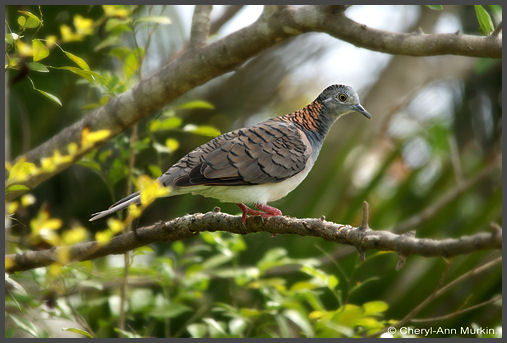
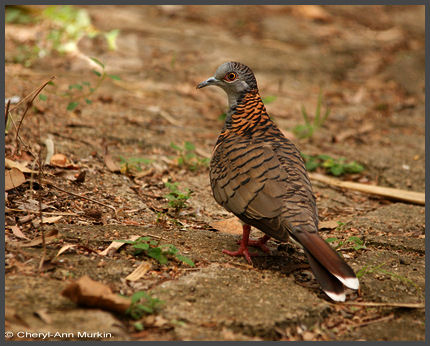
APODIFORMES: Apodidae: Swifts.
White-throated Needletail:
Fork-tailed Swift:
Usual sightings when noted with photographs: 20 February, 2013. Sightings every year but no photos, although I have to go through photos to find sightings from more recent years.
6 April, 2015: Came out to front yard with camera to take photos of our Sunbird family and at 6:59am found the sky full of Fork-tailed Swifts and noted a smaller number of White-throated Needletails which hung around hawking for insects above and around our property for over an hour, with a couple of strays still left when others dispersed. I counted 15+ after about 3/4 hour that I could see from my front yard.....due to the high canopy and sun.
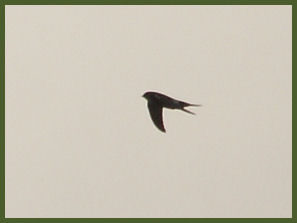 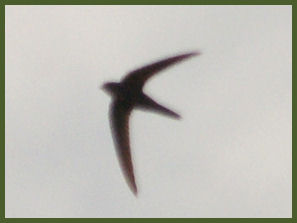
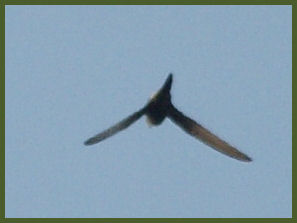 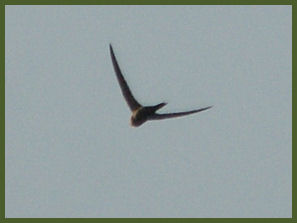
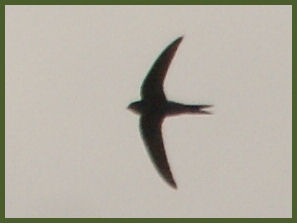

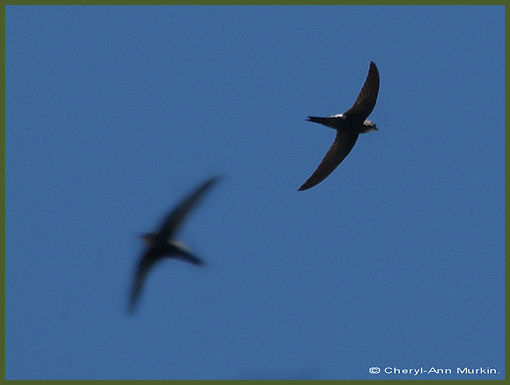
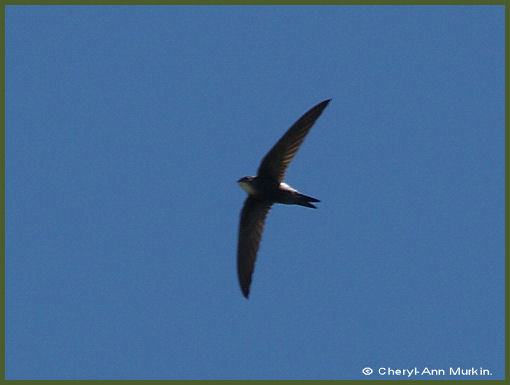
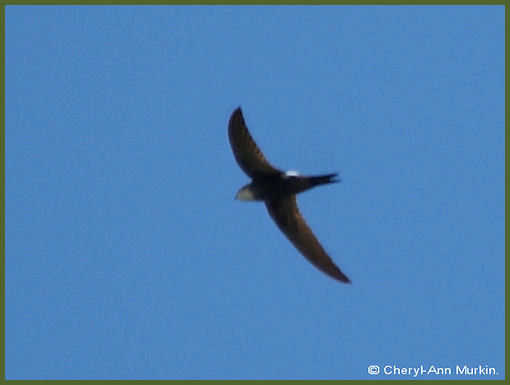

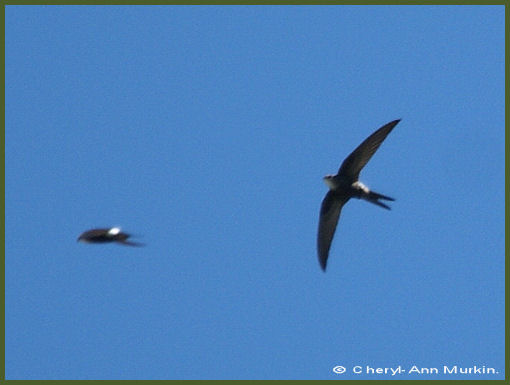
PHALACROCORACIFORMES: Family: Anhingidae: Darters.
AUSTRALASIAN DARTER / AUSTRALIAN DARTER - Anhinga novaehollandiae (International).
The following images of this Australian/Australasian Darter were taken looking over Rowes Bay from the Jezzine Barracks new boardwalk at Kissing Point headland, Townsville on Sunday 27 / 04 / 2014. Female or immature Darter, a little difficult to make out at this distance.
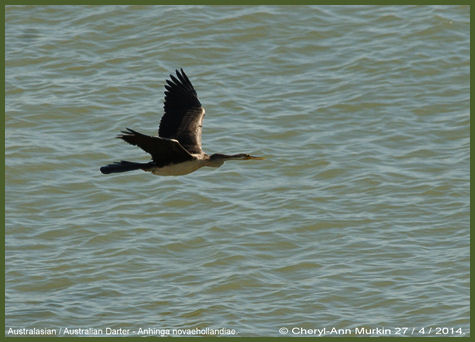

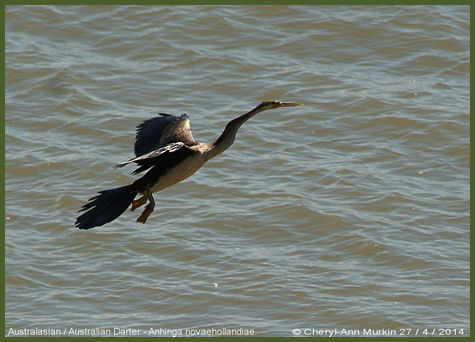
Darter's landing gear coming down preparing to land.
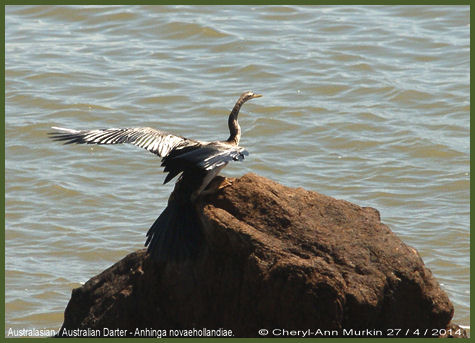
Darter touching down.
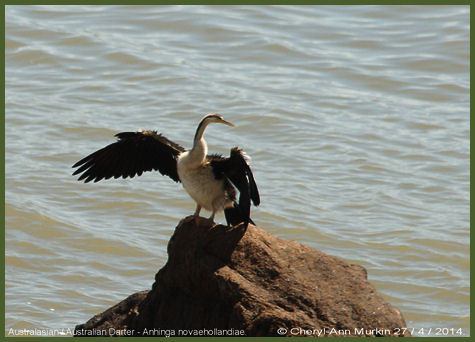
Australasian/Australian Darter drying it's wings.
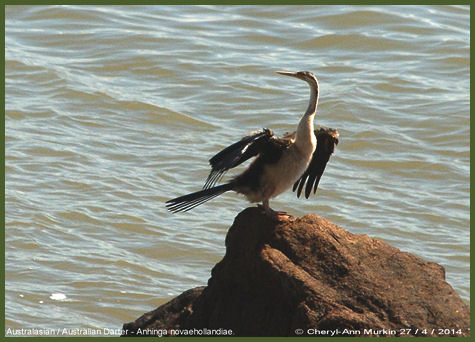
The two images below of the Australian/Australasian Darter were taken at the Borrow Pits (opposite the Ross River Dam on Sunday 27 / 04/ 2014. (Freshwater habitat).
cheryl-annmurkin.jpg)
Time taken: 1:09:23 PM. Borrow Pits, Ross Rvr Dam.
cheryl-annmurkin.jpg)
Darter taking off. Time taken: 1:09:26 PM.
PHALACROCORACIFORMES: Family: Phalacrocoracidae: Cormorants and Shags.
Little Pied Cormorant - Phalacrocorax melanoleucos.
Occasional visitors to our pond. More so in the earlier years of our pond before plants got large.
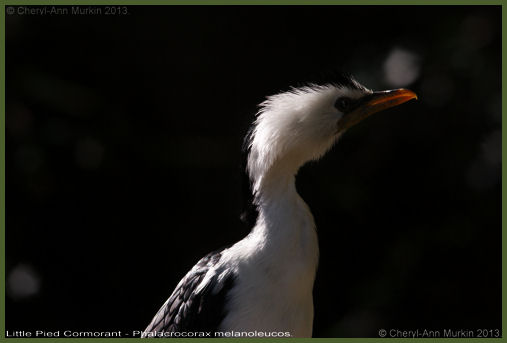
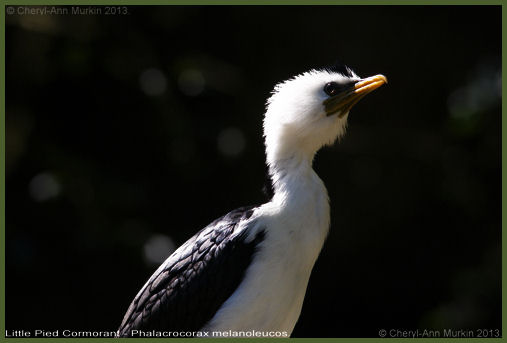
CICONIIFORMES: Family: Pelecanidae: Pelicans.
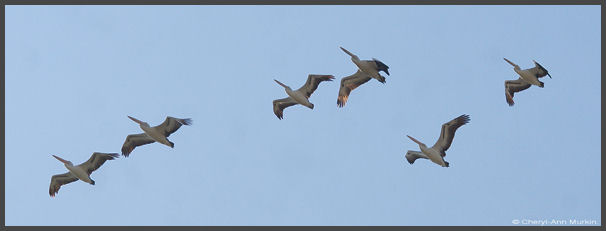

CICONIIFORMES: Family: Ardeidae: Bitterns, Egrets, Herons.
White-necked (Pacific) Heron - Ardea Pacifica.
Poor images. These are distant images of White-necked Herons in flight, from what I can gather they are a family of two adults and an immature/Juvenile. The first image is one bird cropped from the second image below.
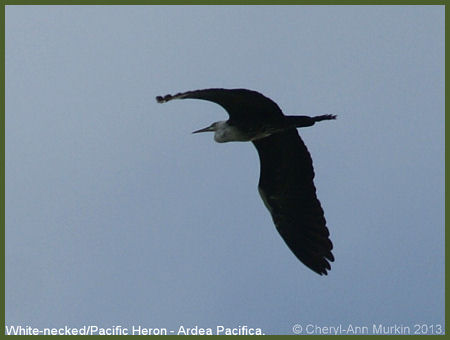 White-necked (Pacific) Heron in flight. Taken: 1 March, 2013 at 5:45Pm.
Cropped from below image.
White-necked (Pacific) Heron family. Taken 1 March, 2013, at 5:45Pm. Distant shots.
Eastern Cattle Egret: Bubulcus/Ardea Ibis coromandus. 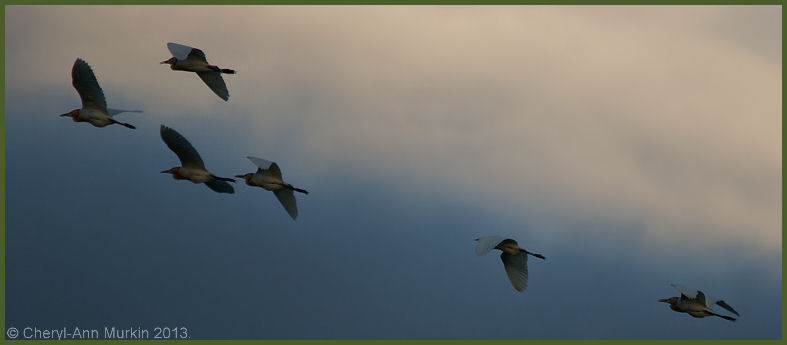 Eastern Cattle Egrets in flight in breeding plumage. Taken 6:33:03Pm 25 February, 2013. Distant shot.
Nankeen/Rufous Night-Heron - Nycticorax caledonicus.
Nankeen Night-Heron, also known as Rufous Night-Heron in Eucalypt overlooking our pond. Regular visitors to our pond.
CICONIIFORMES: Threskiornithidae: Ibises and Spoonbills. Australian White Ibis (formerly Sacred Ibis) - Threskiornis molucca:  b-cheryl-annmurkin.jpg) 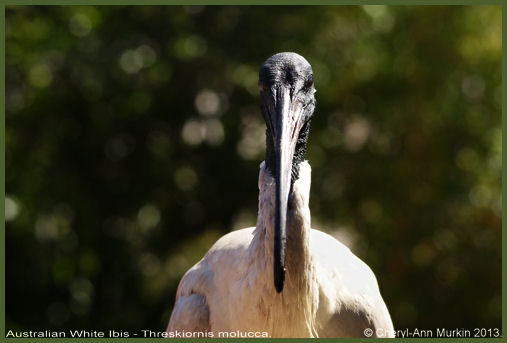 Straw-necked Ibis:  ROYAL SPOONBILL: Platalea regia: YELLOW-BILLED SPOONBILL: Platalea flavipes: ACCIPITRIFORMES: Family: Accipitridae: Hawks, Kites and Eagles. Not entirely in taxonomical order. Sorry.
PACIFIC BAZA - Aviceda subcristata:Formerly known as Crested Hawk. One of our lesser known but more attractive birds of prey, and a regular visitor to our yard, always see them visiting and flying about.
Below: photos taken: Saturday, 27 June, 2015. Six Pacific Bazas, three in our yard at the time, another flew into our side Eucalypt later. Another three in neighbour's yards.



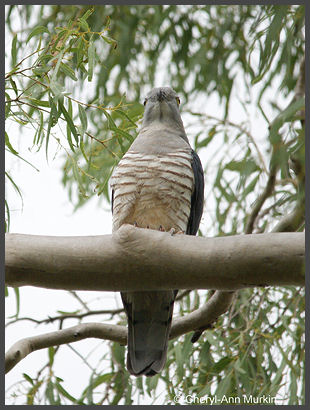
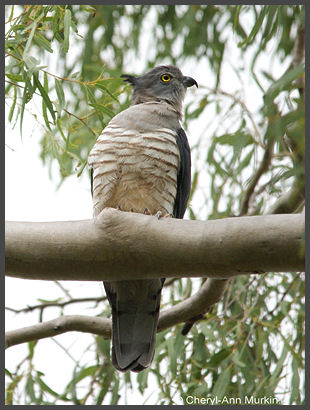
Below: Two Pacific Bazas in our yard - 16 September, 2014.
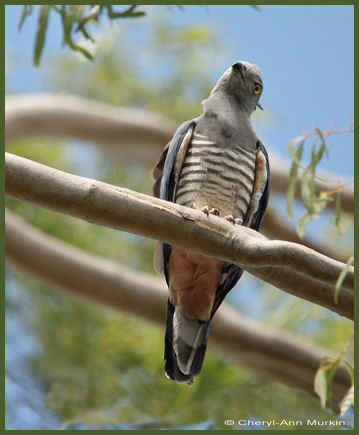
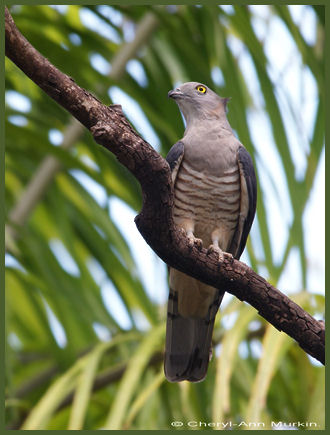
Two Pacific Bazas in our yard on 16 September, 2014. Took lots of photos of these guys. These two stayed just far enough away from each other that I didn't get a photo of both of them together. The one on the right caught itself a large phasmid.
Had another Pacific Baza in our yard yesterday morning and this morning (Monday 13 April, 2015) but decided not to bother trying to photograph it due to the low light in our backyard 'jungle'.

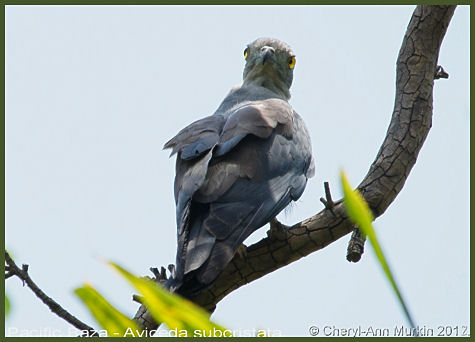 These were some of the second batch of images taken of this Pacific Baza, which I "stalked" for quite some time. I wasn't missing the opportunity!.
I first noticed the Baza when it flew up to the first branch of the Eucalypt from the pond, however where the Baza was perched I was shooting straight into the Sun. The Baza flew away from the pond for some time, and I waited with camera in hand hoping for it's return. He/she returned to another branch and was relentlessly attacked by other birds who obviously thought he/she was a threat to their nestlings. Eventually after much harassment the Baza flew away again and returned later to perch in a large fig tree for protection and to hopefully hunt in peace. He/she returned to another branch of the Eucalypt with a frog.
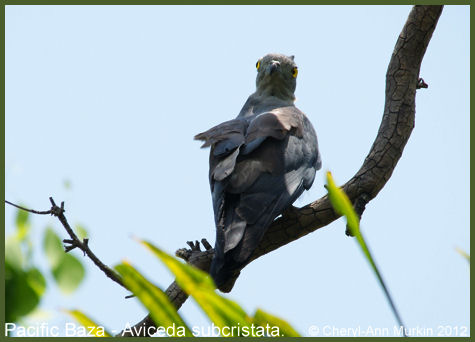 
 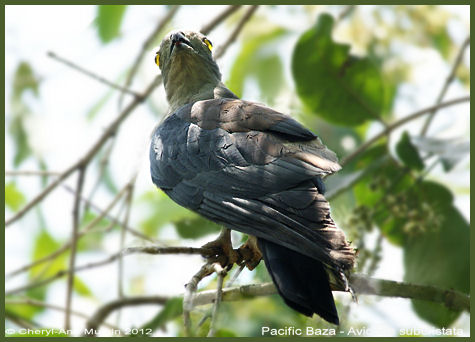 Pacific Baza in Sandpaper Fig still concerned about harassment from other birds. 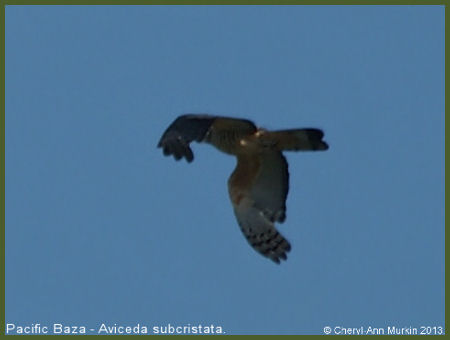 Very distant image of a Pacific Baza in flight. Date taken: 2013.  Pacific Baza in flight. Date taken: 10/4/2014. Just lucky to capture this guy flying off into the distance. Too busy watching a Whistling Kite & Wedgie to notice him at first. The Pacific Baza took off from our yard and was flying off before I could raise the camera. 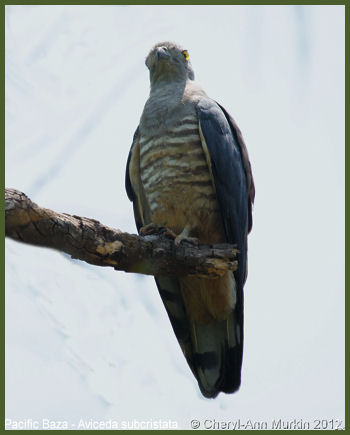 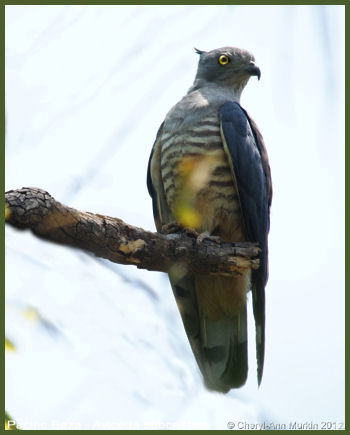 Very first shots of the Pacific Baza above. Shots taken into the sun. Date taken: 7 Dec, 2012. Close to midday. 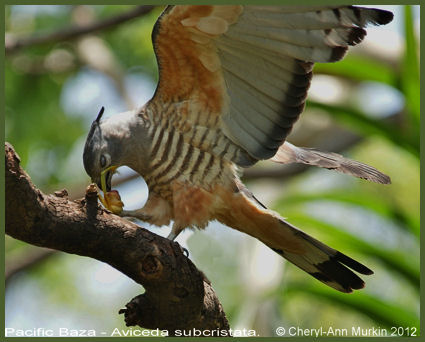 Pacific Baza with frog prey. Demonstrating the nictitating membrane over eye. Crop of another image - demonstrating the Baza's magnificent eyes and double-toothed bill. 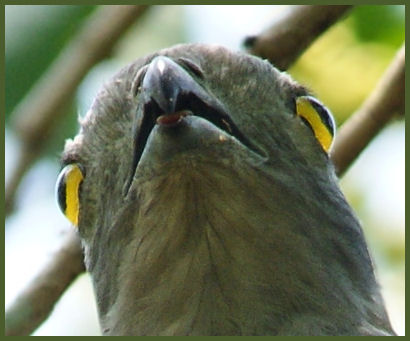
Black-Breasted Buzzard:
BRAHMINY KITE: Haliastur indus:
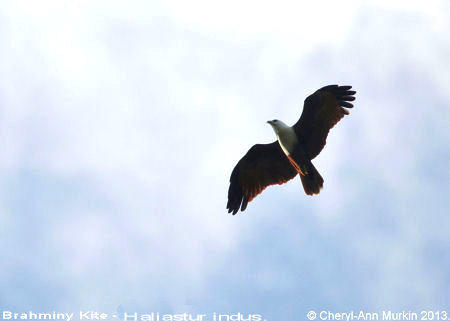 WHITE-BELLIED SEA-EAGLE - Haliaeetus leucogaster. Date taken: Sunday, 27 / 04/ 2014 at Ross River, Townsville, 12:38 PM. I believe that this may possibly be a second to third year Immature White-bellied Sea-Eagle. According to numerous sources on WBSE plumage on the internet - full adult plumage is obtained at between 4 and 6 years.....obviously there are many factors involved!. I have often seen these guys perched in the large Eucalypts - pretty close to the road on Riverway Drive. I often see adults and juvenile WBSE fly over our property.  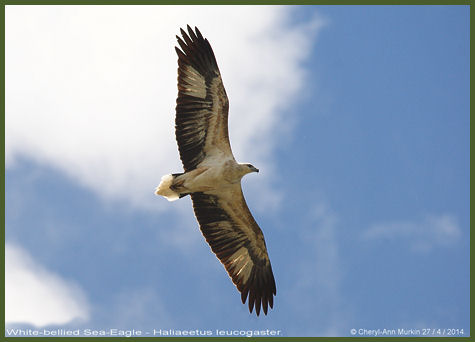
BLACK KITE, AKA: Fork-tailed Kite: Milvus migrans affinis. Top right photo - Who's chasing who? - The White-breasted Woodswallow is harassing the Black Kite!.  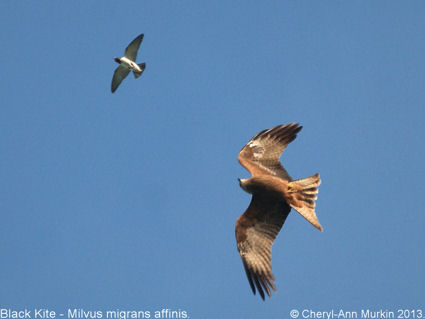

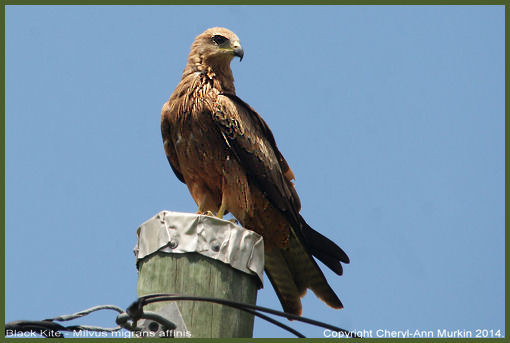

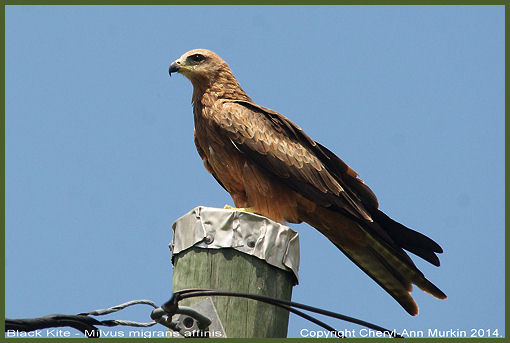

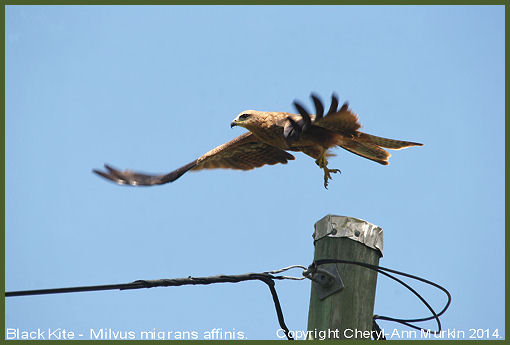 Black Kite taking off from power pole. The last raptor I saw on this power pole was a Wedge-tailed Eagle and that was around a month before I purchased my new camera.
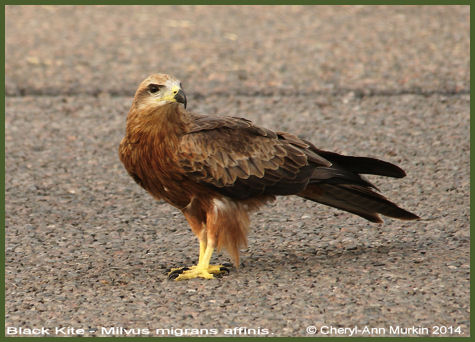
Black Kite getting a snack off the road in front of our property. Had to stand on a couple of blocks and hang over a 6 foot fence for this one LOL.
WHISTLING KITE: Haliastur sphenurus. Some authorities - Milvus sphenurus.

Whistling Kite in flight.
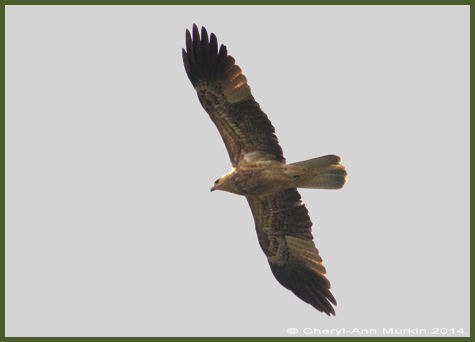
Whistling Kite in flight.
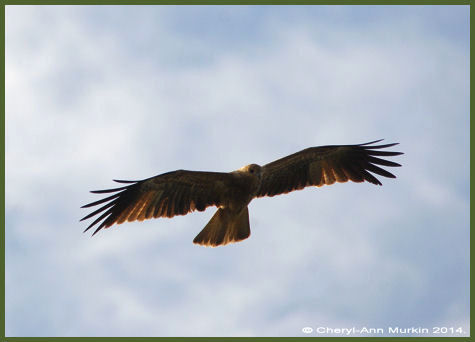
Whistling Kite in flight.
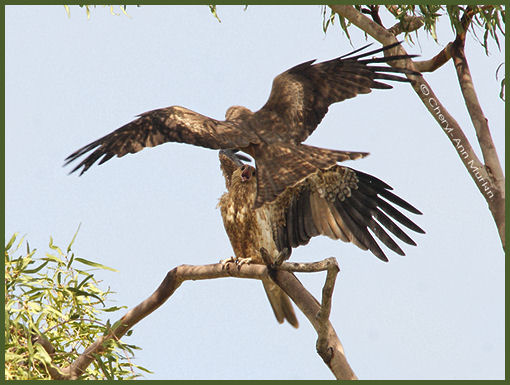
Whistling Kite being harassed by a Black Kite.
BROWN GOSHAWK: Accipiter fasciatus.
Below photos of an adult Brown Goshawk flying a little lower down than when the last photos were taken, so a little better - taken: 28 May, 2015 at 11:48am.
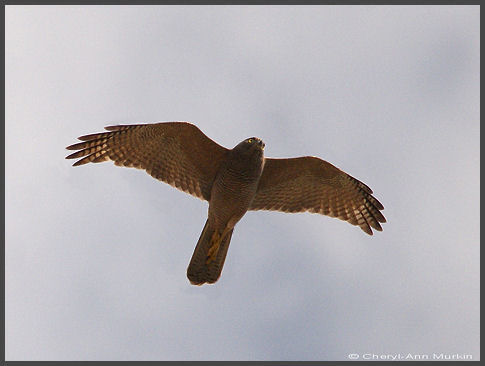
Adult Brown Goshawk in flight.
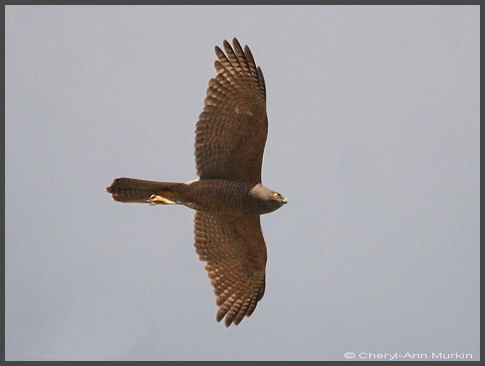
Adult Brown Goshawk in flight.
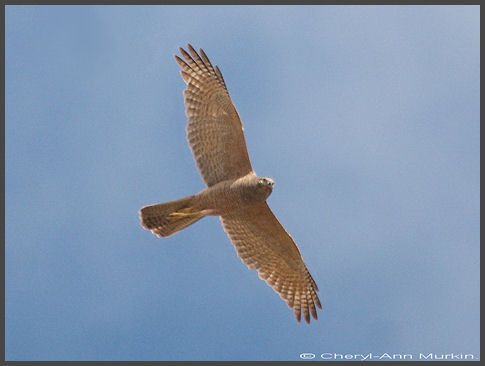
Adult Brown Goshawk in flight.

Above - Adult Brown Goshawk in flight.

Above - Photo of Immature/Juvenile Brown Goshawk - taken: 23 May, 2015 at 12:25:06pm.

Above - Photo of Immature/Juvenile Brown Goshawk - taken: 23 May, 2015 at 12:25:07pm.
Below are two photos of a Juvenile/Immature Brown Goshawk taken from a long distance probably around 60m-100m, will have to check that. The top photo is cropped from the bottom photo crop. Photo taken 11 March, 2013 @ 5:29:59pm. Only basing ID on what looks like a heavy brow from this distance, female Collared Sparrowhawks can look as stockily built as a Male Goshawk.
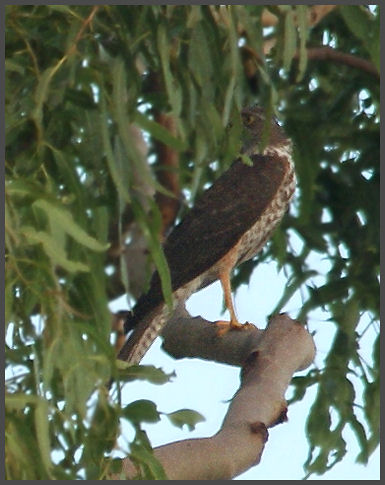
Photo of Juvenile/Immature Brown Goshawk. Although the head appears to be a bit small for a BG.
I've actually experimented with the below photo of a Juvenile/Immature Brown Goshawk and Great Bowerbird (bottom left). There is actually two and half to three times the amount of foliage between them than there is in this photo but it would have made a very wide photo if I would have left it as original, this is the first time I've tried this!. The Great Bowerbird looked rather concerned at the original distance....imagine if they were only this close apart!!!!!.
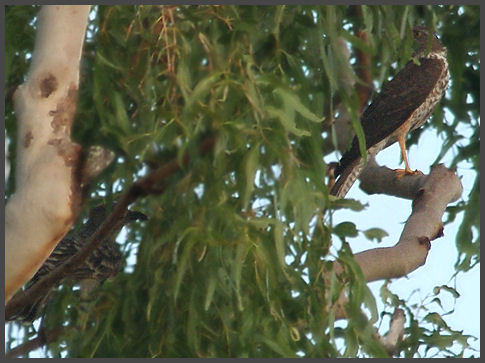
Below are photos taken of a Brown Goshawk soaring high, there were two Brown Goshawks soaring together on the 6 May, 2015 - (with White-browed Woodswallow), the other Brown Goshawk further out. Earlier in the morning there was a mixed flock of Masked and White-browed Woodswallows heading towards the East of our property, and this Woodswallow was one of the stragglers left at 12:26:01pm.
The other photos (B&W) - only one Brown Goshawk present at the time soaring up high, photos taken on the 5 May, 2015, unfortunately still had a setting of ISO 800 from the evening before so very noisy, (400 ISO on my camera is noisy enough) thought they would work OK as silhouettes though.

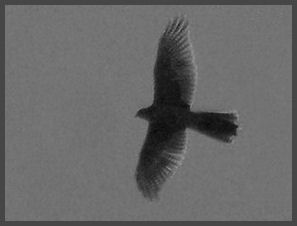 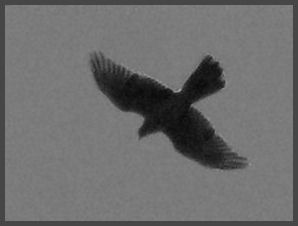
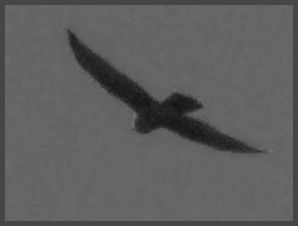 
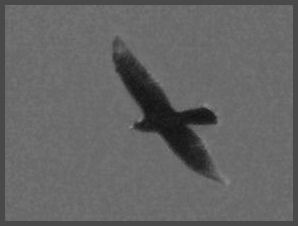 
Last 3 photos taken on 6 May, 2015 Brown Goshawk soaring high, another Brown Goshawk present, but out of shot. Lower ISO this time!.
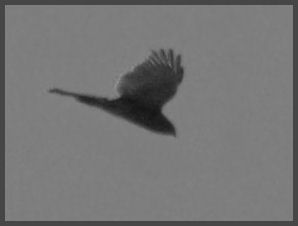 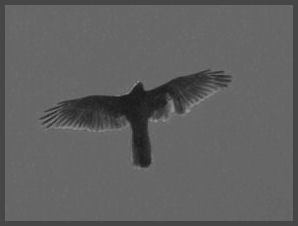
The very first photos I took with my new lense. Unfortunately I had an ISO of 100, always caught out with the wrong settings!. the Focal Length was 150mm, pity about the other 350mm!. These are very tight crops from larger images. This Goshawk was hunting a Peaceful Dove, which I found very much alive after taking these photos, and the Goshawk flew off. EDIT: Lonesome Dove - was watching the series at the time!!!.....it was a Peaceful Dove!!....deh!!.
  
This adult Brown Goshawk was hunting down a Peaceful Dove which I found alive and well later. I believe this was a male Brown Goshawk due to it's smaller size.
COLLARED SPARROWHAWK: Accipiter cirrhocephalus.
Finally got some photos of the Collared Sparrowhawk yesterday!!!, Saturday 13 June, 2015. I'm thinking probably male Sparrowhawk due to slightly notched tail. He was being attacked by White-breasted Woodswallows who were actually crashing into him, he called out every time they hit him.
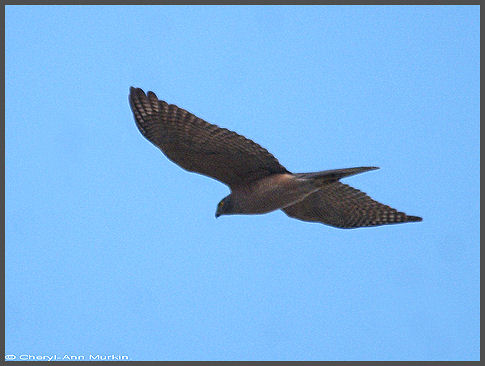
Collared Sparrowhawk in flight -taken: Saturday, 13 June, 2015 at 1:34:19pm.

Collared Sparrowhawk in flight - taken: Saturday 13 June, 2015.
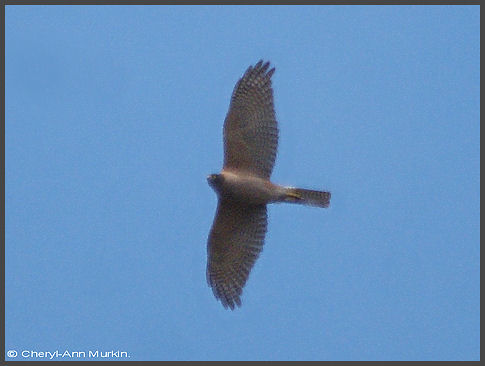
Collared Sparrowhawk in flight - taken: Saturday 13 June, 2015.
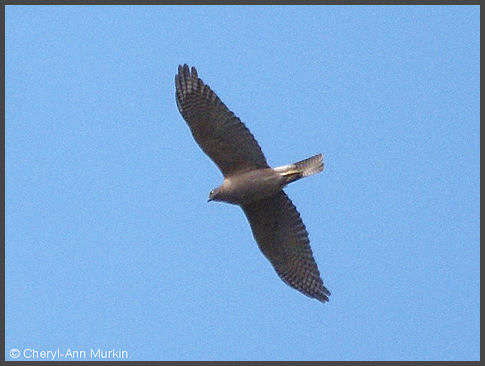
Collared Sparrowhawk in flight - taken Saturday 13 June, 2015.

Collared Sparrowhawk in flight - distant shot.
WEDGE-TAILED EAGLE: Aquila audax.
Latest sighting: 2 x Wedge-tailed Eagles - May 15, 2015 @ 3:51:16pm. First noticed around 10 excited Black Kites which appeared to be attacking another bird (probably a Wedgie), came inside to get my camera and saw two Wedge-tailed Eagles, fairly low at first, then quickly gained height.
2014: The first shots of this Wedge-tailed Eagle -flying away from me, too busy trying to get a shot of a Cuckoo in a Eucalyptus tree, when I saw a shadow and heard it's call.

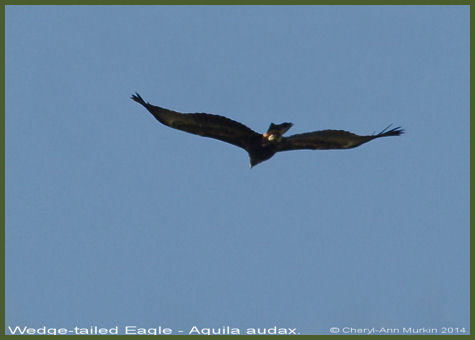
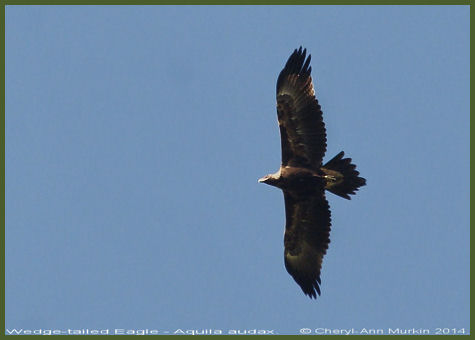
Fairly high up by now.
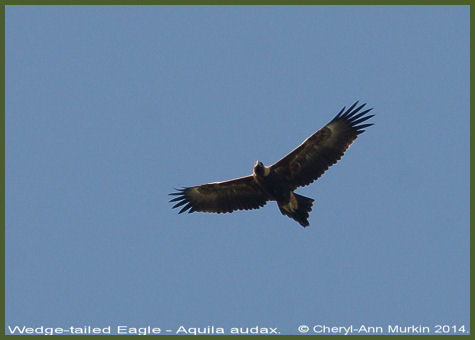
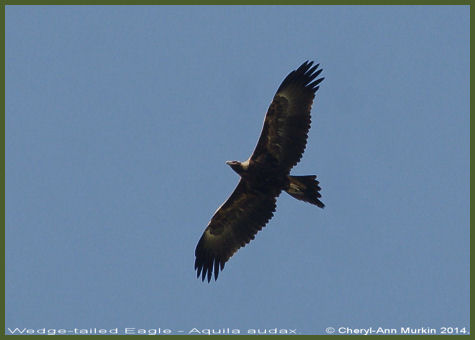
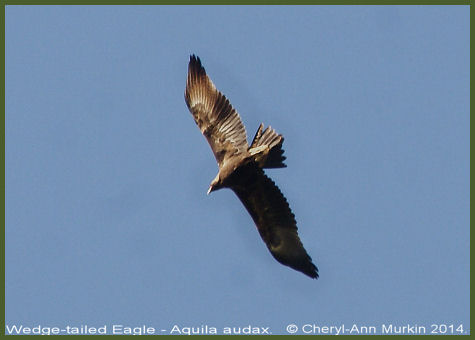


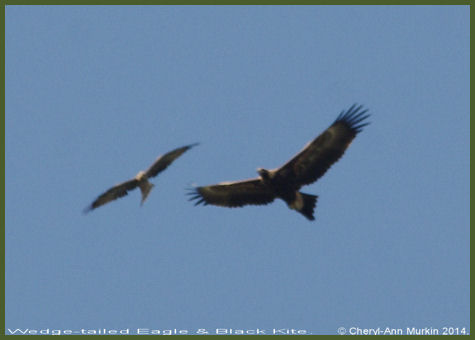
Soaring up very high - poorer blurry shot - comparison of sizes of Eagle & Black Kite.


Soaring very high up, hence the very blurry shot. Comparison of size of Wedgie and Black Kite.
FALCONIFORMES: Family: Falconidae: Hobbies, Falcons, Kestrels.
BROWN FALCON: Falco berigora:
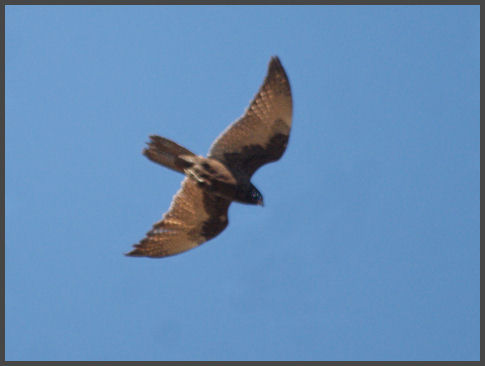
AUSTRALIAN HOBBY / LITTLE FALCON - Falco longipennis:
 
Date Taken: 30/3/2014 - 10:58:59. Date taken: 30/3/2014 - 10:59:02.
Australian Hobby / Little Falcon in flight. Taken from home - front yard. Just lucky to capture these two images of this beautiful falcon as I was watching some Black Kites harassing a Wedge-tailed Eagle.
I have added two captive images below of an Australian Hobby and Peregrine Falcon to show differences
between the two birds as Hobbys in flight are often mistaken for Peregrine Falcons particularly Juvenile Peregrines.
I intend to set up a captive bird page but will use these two captive bird images for comparison until I get a shot of a wild Peregrine and close up shot of a Hobby.
I captured the images below at one of the QBE Free-flight Bird Shows I attended in October last year. They are small crops from larger images and were taken from the shrubs at the very top of the bird show ampitheatre.

Date taken: 13/10/2013 - 12:25:25. QBE Free-flight Bird Show at Taronga Zoo, Sydney. Lunchtime show.
PEREGRINE FALCON - Falco peregrinus:
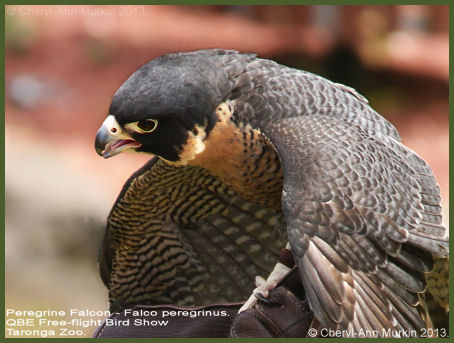
Date Taken: 13/10/2013 - 12:42:28. QBE Free-flight Bird Show at Taronga Zoo, Sydney. Lunchtime show.
GRUIIFORMES: Family: Gruidae: Cranes.
BROLGA: Grus rubicundus.
 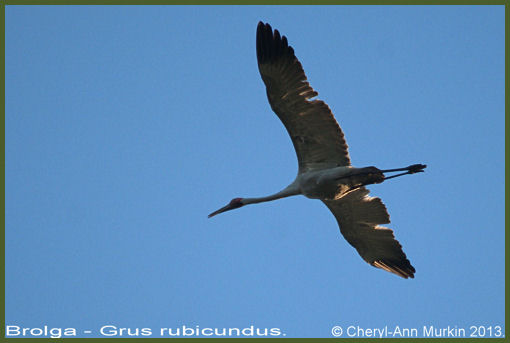
Above: Brolga in flight: Images taken 2nd April, 2013 @ 7:19 PM or AM.  Above photo of 2 Brolgas in flight, there were 3 but the other one was lower down out of shot. Taken: 2 June, 2015 at 10:02:55am. GRUIIFORMES: Family: Rallidae: Rails, Coots and Crakes.
PALE-VENTED BUSH-HEN, AKA: Rufous-tailed Bush-hen or Swamphen. Amaurornis moluccana.
I have only seen them once this year (2015) for a brief period. My dogs always announce the birds' presence long before I see them...just because I don't see them doesn't mean they are not there!.
Below are several images (not the greatest) taken in January 2013 at our pond on our property of the illusive Pale-vented Bush-hen (AKA: Rufous-tailed Bush-hen or Swamphen. Amaurornis moluccana.
We have been so fortunate to not only have these guys visit us on a regular basis over the years, but to also have them breed annually on our property.
Known to most birdos/birders as TURBO CHOOKS for good reason......they are shy and extremely cautious birds which move like lightening....Although they have been here for many years they are so difficult to see let alone photograph!!....and be warned - they can step through a chain wire fence like it wasn't there!!...and at great speed....with a hole 8 to 8 1/2cm diameter at the widest point they can pass through this like a ghost. Other members of the Rallidae family who have been regular visitors to our property over the years include the Purple Swamphen and Dusky Moorhen.

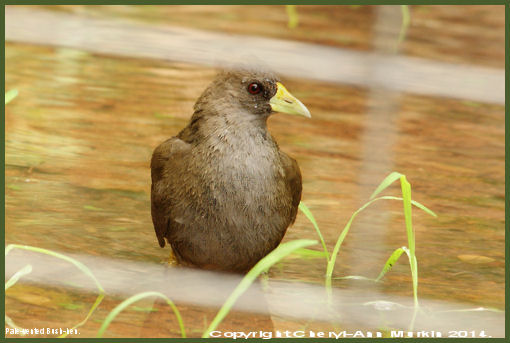
Above photo of Pale-vented Bush-hen: Date Taken: 9/2/2014. 12:35 PM. First sighting for 2014. Enjoying the rain on one of the paths to the pond.
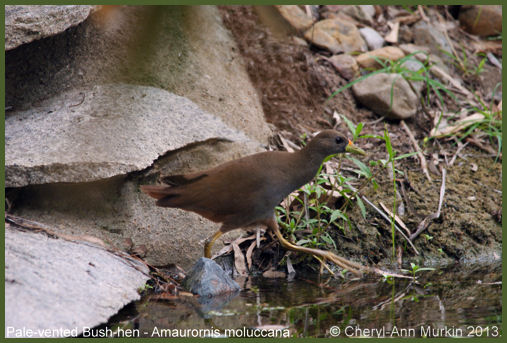
This male Pale-vented Bush-hen led me on many a merry chase away from the female/and young, including swimming across the pond, while I was trying to get these photos.


Above photo: This Pale-vented Bush-hen just passed though this chainwire fence. 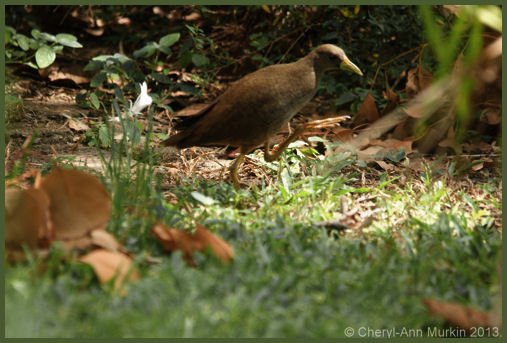
Above Photo: Pale-vented Bush-hen running back to nest when it spotted me.
Date taken: 18/1/2013. 1:55:18 PM.
-cheryl-ann-murkin.jpg)
Pale-vented Bush-hen in pond. Poor image but only one with tail up.
Date Taken: 18/1/2013. 2:04:15 PM.
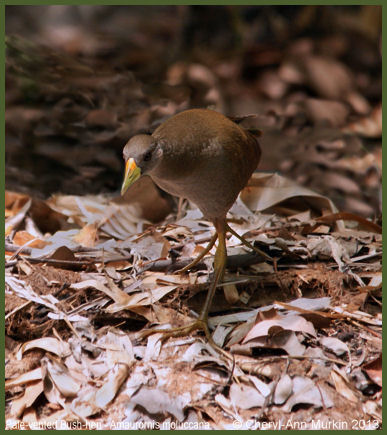
Above: Pale-vented Bush-hen heading down to the pond for a dip.
12.35PM Sunday, 9 February, 2014:
I am so happy that our pair of Pale-vented Bush-hens have returned to breed on our property once again.. I was beside myself to see them back again!!!. Last year we received over a metre of rain and feared that with their choice of nesting sites - (at the end of one of our pond's creeks) that rain water may have inundated their nest, hopefully they have chosen higher ground for their nest this year!.
Took the photo above dated 9/2/2014 along with several others today and couldn't resist uploading it to my website.
I thought I heard the bush-hens calling weeks ago but without a sighting, I felt that maybe it was just wishful thinking - considering the state of their pond as they love the water!.
They usually arrive around October/November each year, but probably not this time..... although they may have been here all along!. Maybe I should start to listen to my dogs!!!.....
I was very concerned that I would never see them again.
Weeks (prior to their arrival - as we know anyway!) we spent cleaning up the pond hoping for their return and many other species of birds that we have missed since our pond's gradual decline following Cyclone Yasi, and have been rewarded with a sudden influx of numerous species.
The pond has been a matted mess of debris, algae and in the last few months has been taken over by a matted layer of grass as many wetlands in QLD have been choked with "ponded grasses" planted by graziers (in good faith) to feed their cattle.
The above photo was taken through the glass of our rumpus room and a gate. This bird and her/his partner were enjoying a bath in puddles on the paths to the pond following much needed rain.
CHARADRIIFORMES: Family: Burhinidae: Stone-curlews.
CHARADRIIFORMES: Family: Plovers, Lapwings:
COLUMBIFORMES: Family: Columbidae: Pigeons and Doves.
PSITTACIFORMES: Family: Cacatuidae: Cockatoos.
PSITTACIFORMES: Family: Psittacidae: Parrots.
RAINBOW LORIKEET: Trichoglossus haematodus.


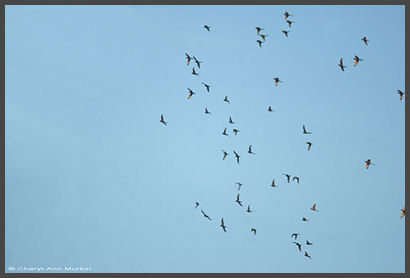
Above photo: I managed to capture these Rainbow Lorikeets which were the remnants of a much larger flock after racing inside to get my camera...I think there were only 47/48 in this shot as opposed to at least 200+ (original estimate) Rainbow Lorikeets present a minute before!!...and I feel that I've definitely underestimated the numbers again after looking at this photo as they were packed very tight doing loops.
CUCULIFORMES: Family: Cuculidae: Cuckoos, Coucals.
EASTERN / PACIFIC KOEL - Eudynamys orientalis.

Sub-adult Male Eastern Koel moulting into adult plumage. This was one of three males, two females and two juvenile koels (one raised by Little Friarbirds) in the yard at the time. Photo taken: Tuesday, December 2, 2014 at 2:58:08pm.
Images of Female Eastern Koel:
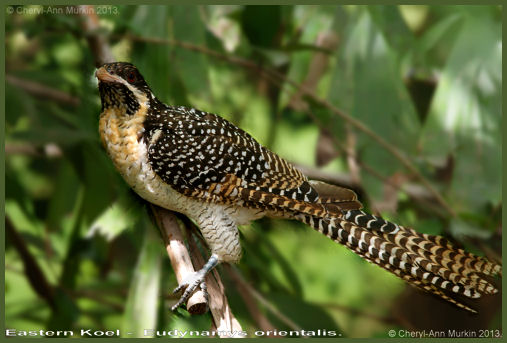
Female Eastern Koel.
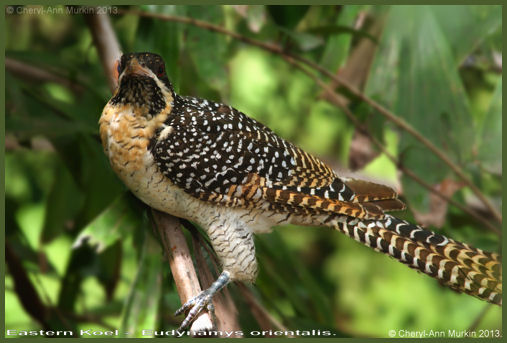
Female Eastern Koel.
CHANNEL-BILLED CUCKOO: Scythrops novaehollandiae:
CORACIIFORMES: Family: Coraciidae: Rollers, Dollarbird:
CORACIIFROMES: Family: Alcedinidae - River Kingfishers / Halcyonidae: Forest Kingfishers and Kookaburras:
LAUGHING KOOKABURRA:
BLUE-WINGED KOOKABURRA: Dacelo leachii:
This Blue-winged Kookaburra was hunting in our neighbour's backyard. Shown here with lizard prey, and a "sponging"/ or TA - 'Trades Assistant' whichever way you want to look at it!! Magpie-lark. These photos were taken at quite some distance. Focused on the Peewee in the last shot.
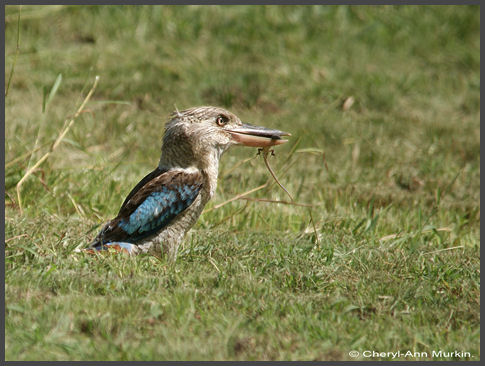
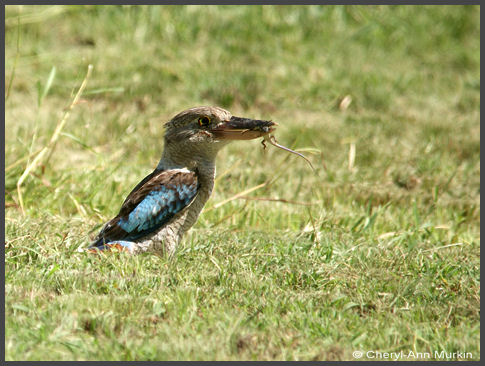

FOREST KINGFISHER: Todiramphus macleayii:
Below: Only photos of a Forest Kingfisher on our property I have. Have had a number of Kingfisher species on the property including Azure and Little Kingfisher. This Kingfisher has been enyoying a dip in the pond, and shortly after these photos were taken went in for another dip!!.
We use to spend a lot of time around the pond, but not so much these days.
Had to brighten these old photos up quite a bit as he/she was almost entirely in full shade, apart from the front of the bird. These were taken from the other other end of our main pond from one of the creek bridges.

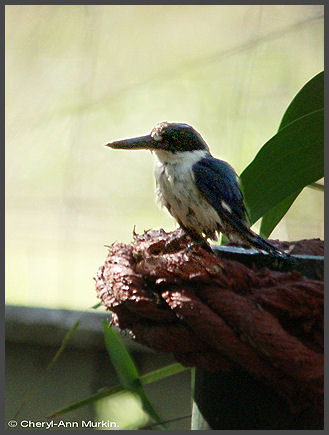
SACRED KINGFISHER: Todiramphus sanctus: This young Sacred Kingfisher is certainly enjoying the rain. Perched on one of the gates to our pond.

Sacred Kingfisher enjoying a shower of rain.

Sacred Kingfisher enjoying the rain.
CORACIIFORMES: Family: Meropidae: Bee-eaters.
PASSERIFORMES: Family: Ptilonorhynchidae: Bowerbirds and Catbirds.
GREAT BOWERBIRD - Chlamydera nuchalis.
We have always had a bower on our property since we first purchased our block of land. It had always been out in the open at the front of the block unfortunately in the last couple of years the birds have moved their bower under a Terminalia and Calliandra shrubs that have taken over that corner of the yard - so I cant get in to get a photo of the bower. On the upside they have raised lots of young on our property and are very entertaining. I have heard our figbirds mimicing the bowerbirds amongst many other birds, but our bowerbirds have a larger repertoire including Rainbow Lorikeet, kookaburra and an excellent Whistling Kite call which I believe is their favourite as they love to repeat it many times a day, and you would swear this kite was sitting in your front yard!!.
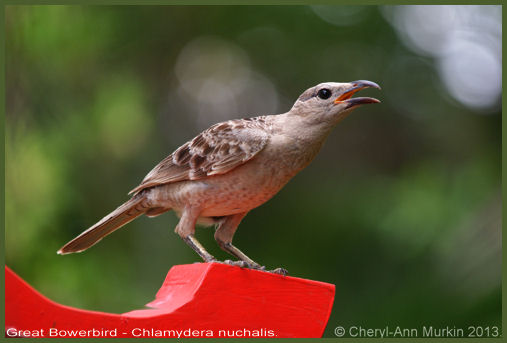
Photo of Juvenile Great Bowerbird.
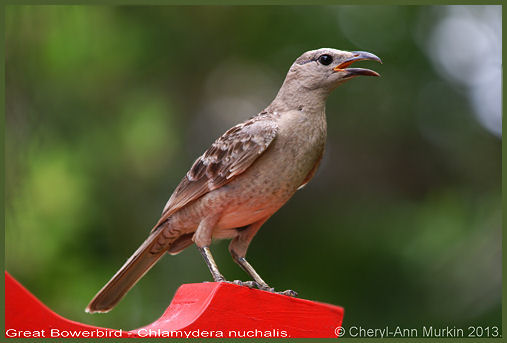
Photo of Juvenile Great Bowerbird.
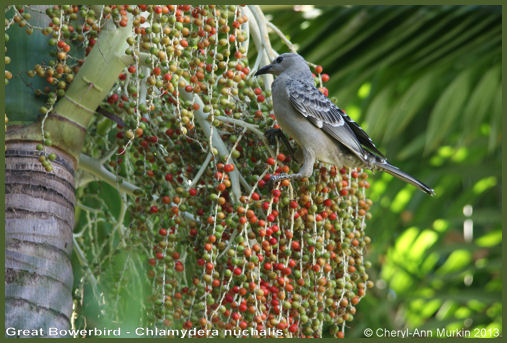
Adult Great Bowerbird feeding on Spindle Palm fruits, in the company of Figbirds, not seen in these photos.
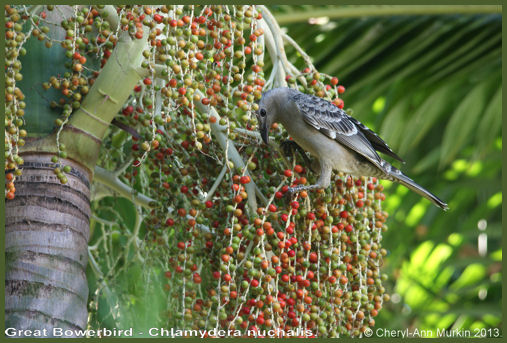
Photo of Adult Great Bowerbird.
Below: Great Bowerbird in Casuarinas.
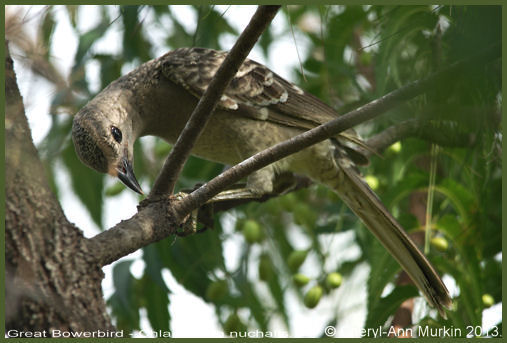
Date taken: 21/2/2013.
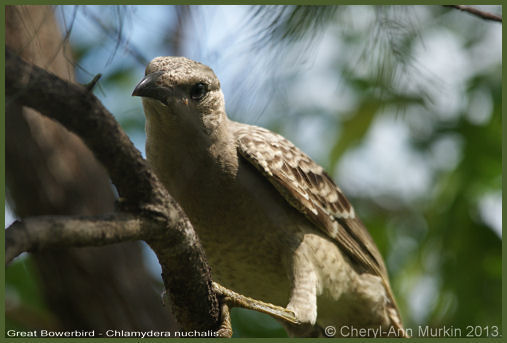
Date taken: 21/2/2013.
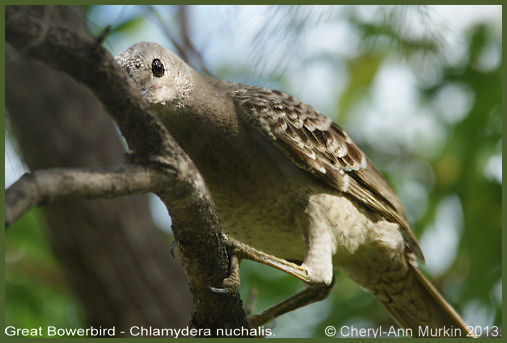
Date taken: 21/2/2013.
PASSERIFORMES: Family: Maluridae: Fairy-wrens, Grasswrens, Emu-wrens.
PASSERIFORMES: Family: Meliphagidae: Honeyeaters: Friarbirds, Wattlebirds, Spinebills, Miners, Bell-miners.
Yellow Honeyeater:
White-gaped Honeyeater:
Yellow-tinted Honeyeater:
FUSCOUS HONEYEATER:
April 25, 2015: At least one pair of Fuscous Honeyeaters feeding high in canopy in eucalypts at the back of our pond around 11-30am, no photos as yet.
Below are two rather poor photos of a Fuscous Honeyeater high up in a Eucalypt taken at around 35 -40m in our yard on January 21, 2015 at 6:49:52am, I believe it to be either a juvenile or non-breeding Fuscous Honeyeater. I often hear them and occasionally see them including this morning but unfortunately no photographs.
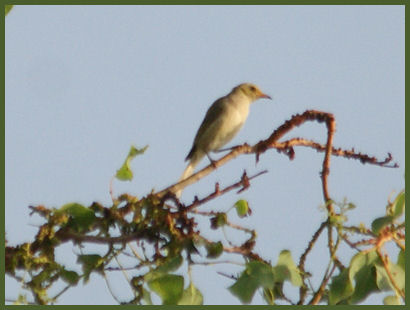 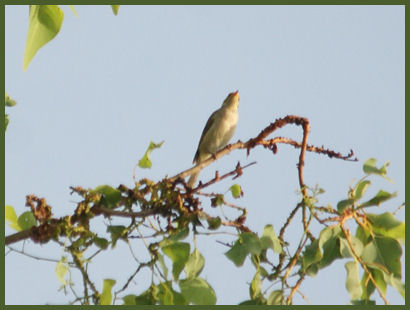
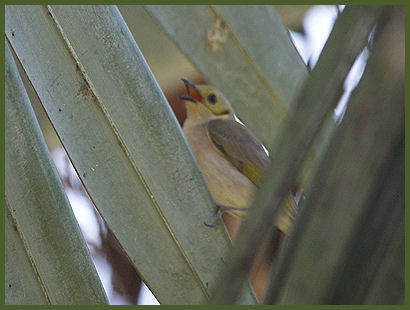
Fuscous Honeyeater, one of a pair in breeding plumage?. Overcast conditions.
Taken: Saturday May 4, 2013 at 10.01am.
If you would have seen this pair of birds (May 4, 2013) in real-life or even a larger photograph you would swear that they could be Yellow-tinted Honeyeaters with all the yellow on them, particularly on the head and throat, primaries, etc; (difficult to make out in this poor photo) and a neck plume more characteristic of a Yellow-tinted Honeyeater.
Townsville has had a history of Yellow-tinted Honeyeaters according to a couple of sources including an article entitled "Yellow-tinted Honeyeaters near Townsville" by A CM Griffin; The Sunbird: Journal of the Queensland Ornithological Society; Vol. 3, No. 2, Jun 1972: 26-28; regarding a colony of Yellow-tinted Honeyeaters on Palm Tree Creek near it's junction with the Black River at the base of Hervey's Range, 27 miles by road NW of Townsville;
and
Wildlife of Townsville Local Government Area on
http://www.wetlandinfo.ehp.qld.gov.au/wetlands/facts-maps/wildlife/?Area ID=lga-townsville
with the last sighting of Yellow-tinted Honeyeaters listed as 31/05/1987.
I would love to know whether they were indeed Yellow-tinted Honeyeaters, Fuscous or even another species or hybrid.
"The Handbook of Avian Hybrids of the World" by Dept. of Genetics University of Georgia has suggested that Lichenostomus are seen to hybridise extensively in well-studied areas of contact. A population (L. subgermana) treated as a race of L. fuscus (Fuscous Honeyeater) and the closely resembling population of L. flavescens (Yellow-tinted Honeyeater) adjacent to it have a narrow hybrid zone in the Dawson-Mackenzie Basin in Eastern Qld.
YELLOW-THROATED MINER: Manorina flavigula: (White-rumped Miner). Native Honeyeater, not to be confused with the Introduced pest Common (Indian) Myna.
Listed as an uncommon bird in the Townsville & District.
We occasionally see small family groups of these guys, but it appears as though this one was alone, and was silently gleaning amongst the foliage.
Getting a few photos of this Yellow-throated Miner high up in our front eucalypt was a bonus, unfortunately I didn't get a photo of my target species which was a very yellow Fuscous Honeyeater which I heard the calls of earlier. By the time I found him/her with my camera the Fuscous Honeyeater was taking off from the other side of the Eucalypt to hawk for insects, sadly it didn't return to it's perch!.. Also present was a Black-chinned Honeyeater which took off prior to the Fuscous.

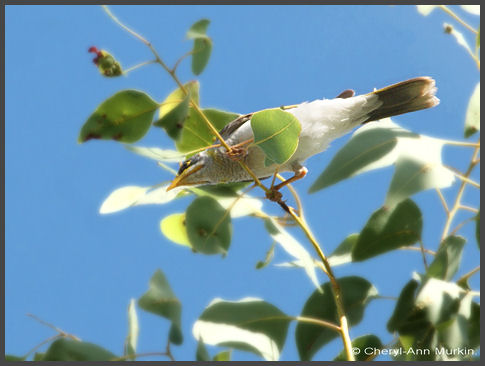
Blue-faced Honeyeater:
WHITE-THROATED HONEYEATER:
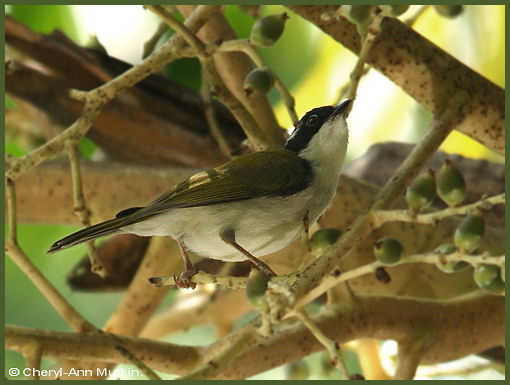
White-throated Honeyeater. One of my older photos.
BLACK-CHINNED HONEYEATER:

Black-chinned Honeyeater chasing insects.
The above photo of this rather yellow-backed Black-chinned Honeyeater was taken: 2 May, 2015 @ 10:26:46am.
There appears to be quite some variation in colouring of the Black-chinned Honeyeaters in the area, not just age-related.
Sorry but the website wont allow me to type in normal text without underlining.
I waited for 4 hours for this particular 'roudy' Black-chinned Honeyeater to do his rounds high up in eucalypts and to eventually start feeding down low in the white callistemon in our front yard (as he'd done before) where I could hopefully get some photos.
After feeding high up in the eucalypt in our front yard he surprised me landing on the powerline just above me, flew out to catch insects on the wing from the powerline, fed briefly in the callistemon, moved onto the fence and gate, then flew out from the gate and fence catching low flying insects close to the ground. Picking them from the air while still in flight and also after landing. He repeated these sallies from fence to ground for sometime.
I have never witnessed any of the Black-chinned Honeyeaters use these types of feeding behaviour before on our property. I've found that Brown, Yellow and White-gaped Honeyeaters to be more foliage/hover-gleaners and hawkers, and are more inclined to land on the ground. White-throated Honeyeaters spend a lot of time gleaning/probing under bark, even more so than gleaning from foliage.
After giving me a great show catching insects close to ground from the fence/gate (just above him), flew back up into the eucalypt above me, then back down to check me out, flying very close to my head. I felt the breeze and heard his wings beat as they brushed closely by me and around the back of my head, he then returned to his fence perch within a couple of metres of me, looked at me for awhile and then returned to our backyard.
I've had many birds come down to check me out including sunbirds, White-throated, Brown-backed, Brown and Yellow Honeyeaters; parrots, woodswallows, kites, etc; but this is the first time for Black-chinned Honeyeaters, a really lovely experience!.
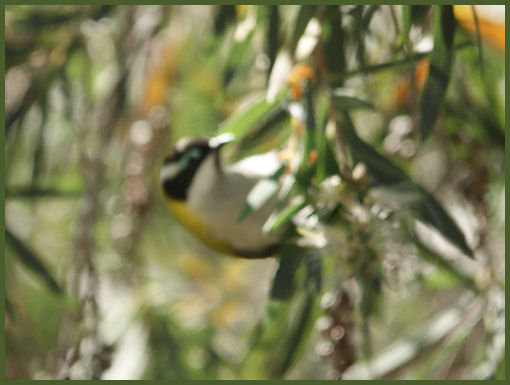
The terrible photo above of a more yellow-backed Black-chinned Honeyeater feeding down low in our white Callistemon taken 10:20am, Tuesday, 28 April, 2015, what surprised me more is that he landed on the ground and went under the golden duranta.
While taking a photo of the Black-chinned Honeyeater below I heard some rather loud calls eminating from the backyard...and this is the guy above. I was thinking that maybe this noisy fellow has gotten a hold of a 'karaoke' machine!!!.
.....determined to get some decent photos of these guys. Tried today but still no luck as yet. Took the camera down the backyard behind our pond chasing down this rather loud Black-chinned Honeyeater and found the backyard full of birds - including Black-chinned, Brown-backed , White-gaped, Brown, Yellow Honeyeater, a couple of Fuscous Honeyeaters; Little Friarbirds, Grey Fantails, Willie-Wagtail, Leaden Flycatcher, White-winged Triller, Rufous Whistler, and others, later joined by more Figbirds and Rainbow Lorikeets.
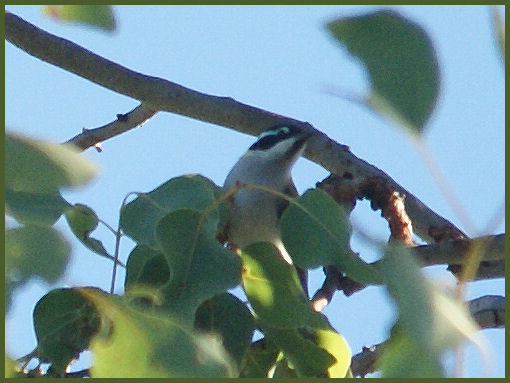
Photo taken: Saturday 25 April, 2015 at 8:13:59am. Black-chinned Honeyeater, one of a pair feeding in same eucalypt as Fuscous Honeyeaters are regularly seen or heard. At this height and distance all you can do is point the camera to where you can hear their call and see a bit of bird movement in amongst wind movement and hope for the best that you can actually capture an image of them!!.
You can hear BCHE calling at any time throughout the day.
April 6, 2015: Same day as Fork-tailed Swifts, heard three separate Black-chinned Honeyeater calls coming from three different directions.
The below photos of Black-chinned Honeyeaters up high in Eucalypt in my front yard.
Photos taken: 23 November, 2014 at 9:34:51am. Have other photos taken at other times including one from 2 March 2014 (one bird out of three birds present that I could see) but worse photos than these. They are around at present, and other times throughout the year, been hearing them daily but difficult to get a decent photograph let alone any at all. Been seeing a couple of them particularly in the last few days.
5 April, 2015: Have been seeing and hearing BCHE very often morning and evenings - usually after 5.30 - 6.00pm. Uncertain whether there are more about or if it's because I've been taking more notice since I bought my camera. Have also seen them feeding with Yellow Honeyeaters in our Ficus benjamina.
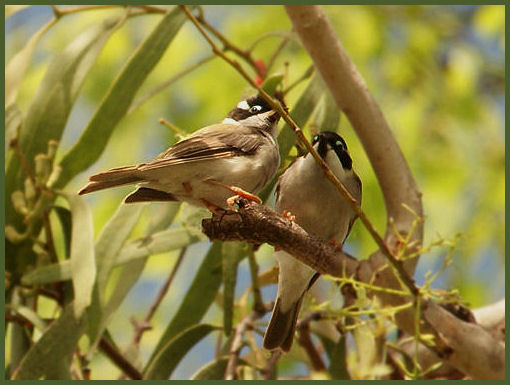
Black-chinned Honeyeaters.
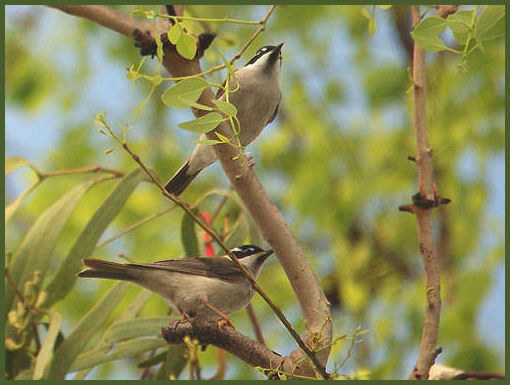
Black-chinned Honeyeaters.
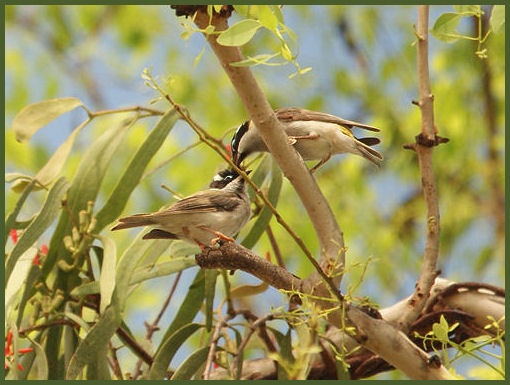
Black-chinned Honeyeaters.
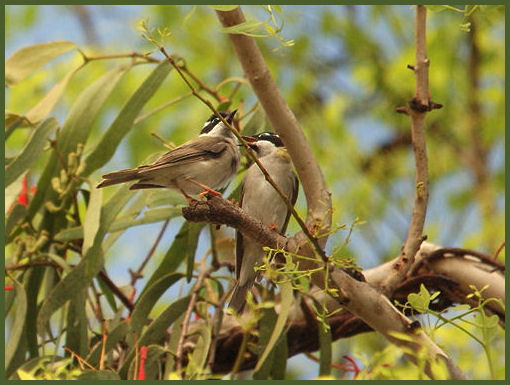
Black-chinned Honeyeaters at our property.
Little Friarbird: Philemon citreogularis.
Photos below of an Immature Little Friarbird - note the yellow on the throat & the chest moulting into full adult plumage. Was feeding with two adults in Callistemon.
Last year (2014) the Little Friarbirds set up nest in the mistletoe in a Eucalypt which was used last year by Figbirds (one of 3 Figbird nests in one tree)
I thought I heard a "ringer" in the nest and I was right. Photos to come. From the 4 January 2015 our Little Friarbirds were continously attacking a male Koel and a pair of Miner birds @ 6:29:54pm....a little too late guys... with the Koel!...... the Little Friarbirds continued to protect their "foster child" - being an Eastern Koel...unfortunately the Friarbirds keep chasing away the Channel-billed Cuckoos which I have been trying to get a decent photo of since I purchased my camera & Sigma lens.
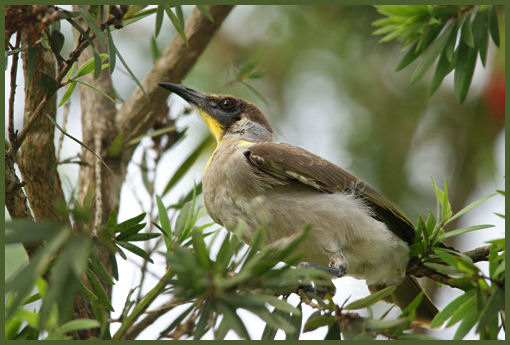
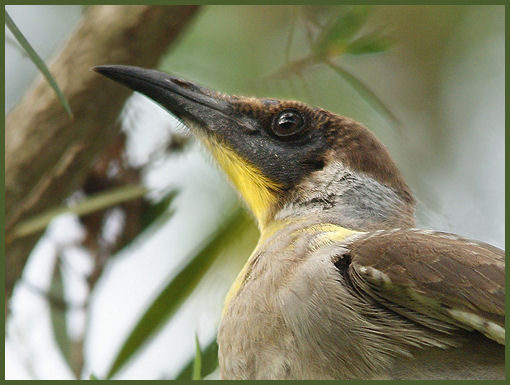
Cropped photo of Immature Little Friarbird.
Helmeted Friarbird:
Brown Honeyeater:
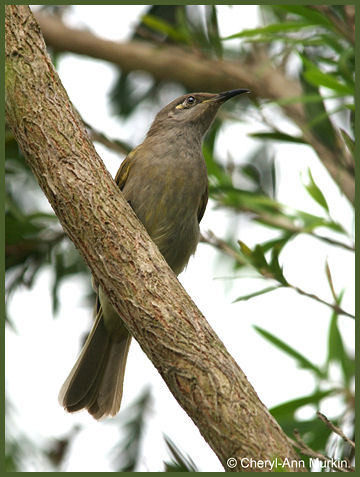 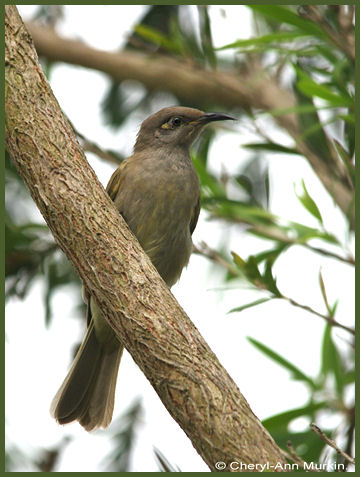
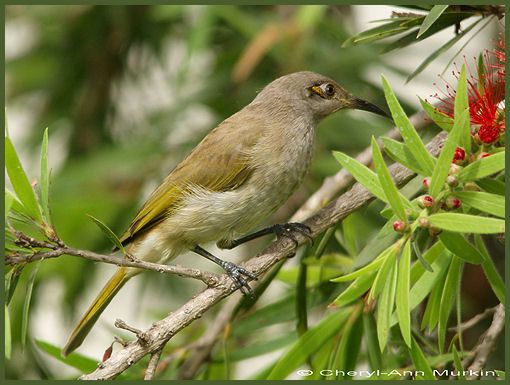

Brown Honeyeater hover gleaning, only had 1/130sec exposure so too slow to freeze action. Taken 26 October, 2014 at 7:54:51 am.
Brown-backed Honeyeater:
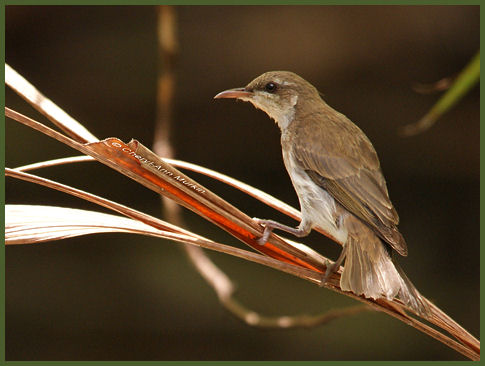

Rufous-throated Honeyeater:
Photos taken: 27 December, 2012.
Another bird that's hard to "pin down" for a photo. They do visit regularly, but always in small numbers. Saw one this morning (24 January, 2015) but no photo.
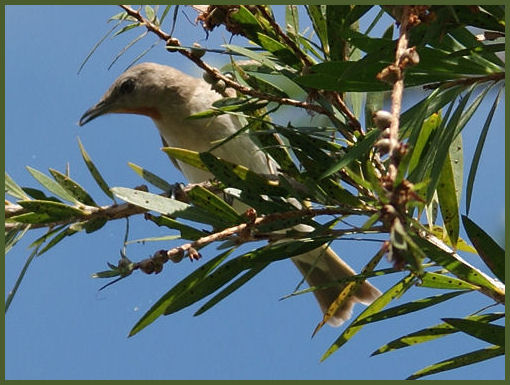
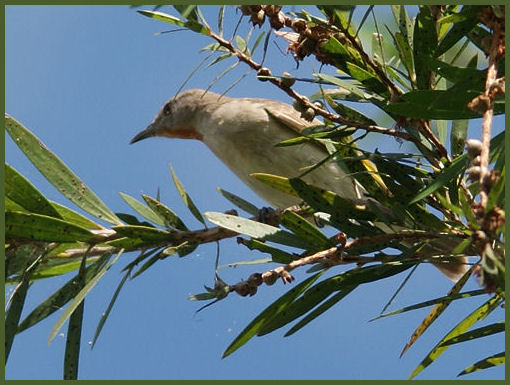
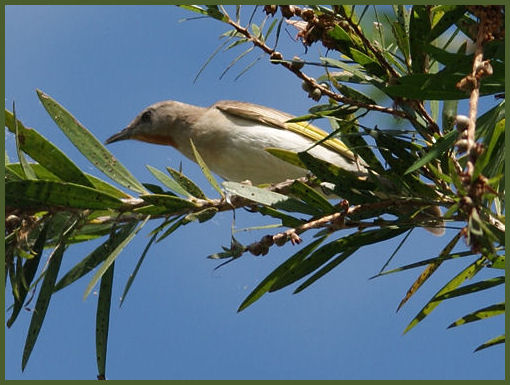
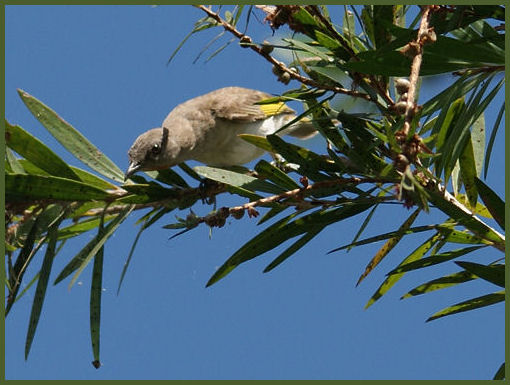
PASSERIFORMES: Family: Cracticidae: Butcherbirds, Magpies, Currawongs. See below.
PASSERIFORMES: Family: Artamidae: Woodswallows.WHITE-BREASTED WOODSWALLOW: Artamus leucorhynchus: 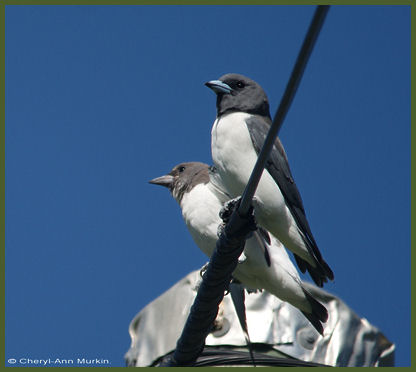  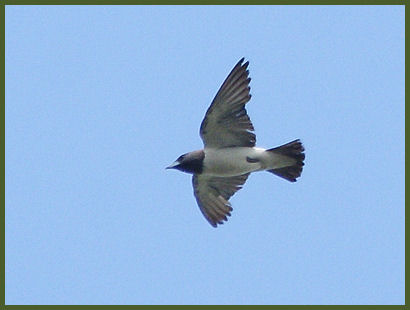 MASKED WOODSWALLOW: Artamus personatus: Mixed flock of Masked Woodswallow and White-browed Woodswallow on 8 April, 2015, hawking for insects, several Fork-tailed Swifts were present. 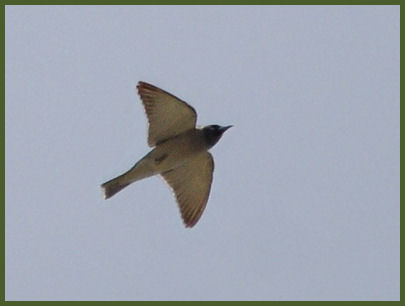 Masked Woodswallow. 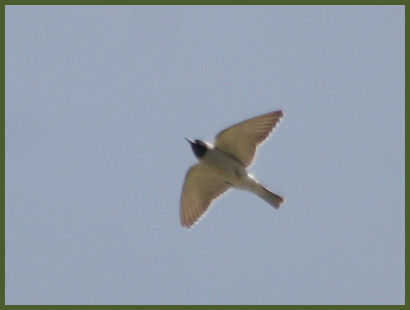 Male Masked Woodswallow. White-browed Woodswallow: The angle this bird was flying you cant see a white brow, and poor quality of the photo - this could possibly be a female Masked Woodswallow, there were plenty of White-browed Woodswallows present that could be positively identified. 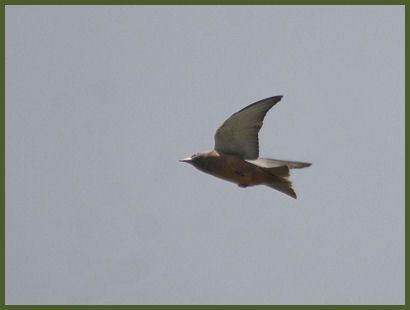 White-browed Woodswallow. PASSERIFORMES: Family: Cracticidae/Artamidae: Strepera graculina: Pied Currawong. 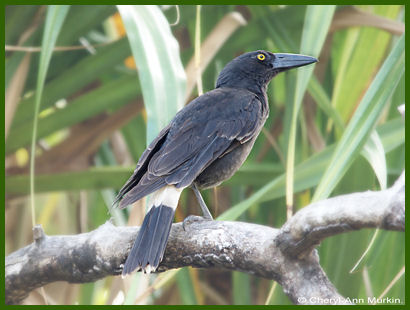  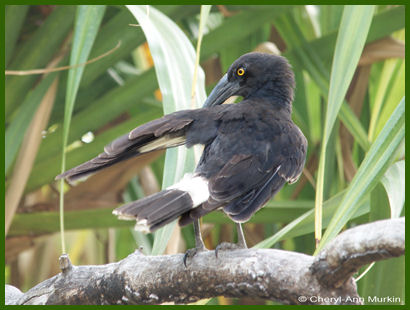 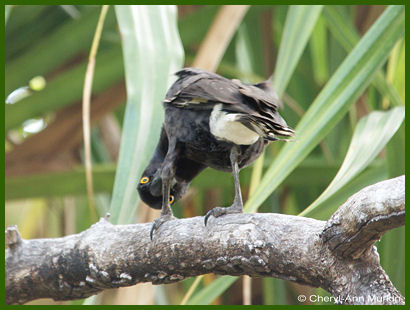   PASSERIFORMES: Family: Campephagidae: Cuckoo-shrikes, Cicadabirds, Trillers. PASSERIFORMES: Family: Campephagidae: Cuckoo-shrikes, Cicadabirds, Trillers.
WHITE-BELLIED CUCKOO-SHRIKE - Coracina papuensis:
Juvenile/Immature White-bellied Cuckoo-shrike.

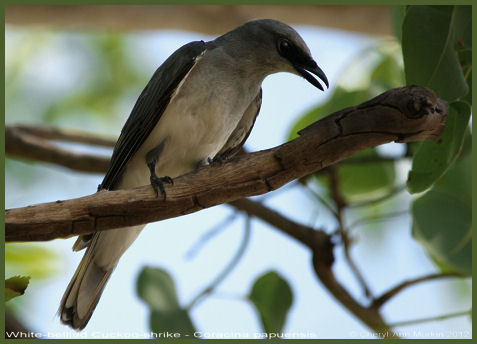

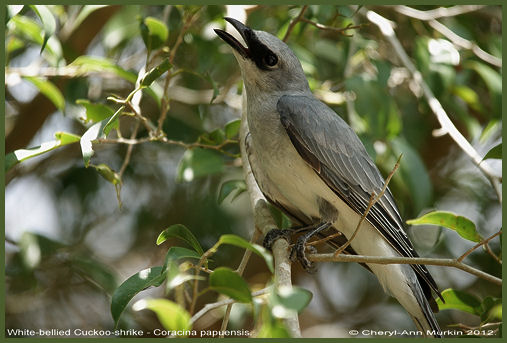
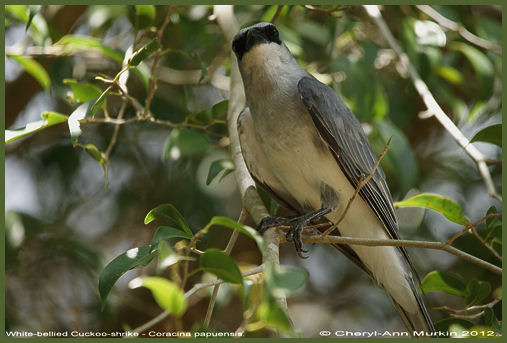
WHITE-WINGED TRILLER: Lalage sueurii (Syn: Tricolor):
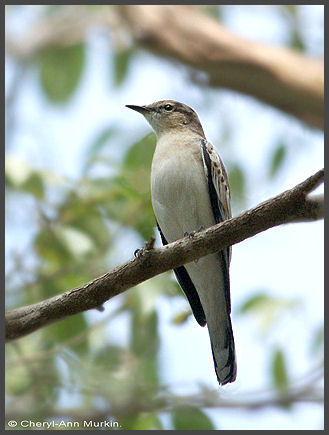
Photo of White-winged Triller taken Sunday, 7 June, 2015 at 1:04:49pm.
Backyard full of many White-winged Trillers and several Varied Trillers feeding on figs and insects. Also present White-bellied Cuckoo-shrikes, Yellow and Rufous-throated Honeyeaters and Leaden Flycatchers.
Below photos of a male White-winged Triller in breeding plumage were taken 11 February, 2013 at 12:46 pm, around 30-40 metres away. While trying to photograph this guy a male Varied Triller landed in a Ficus benjamina just 10-12 feet in front of me, by the time I pulled back the lens he was gone!.
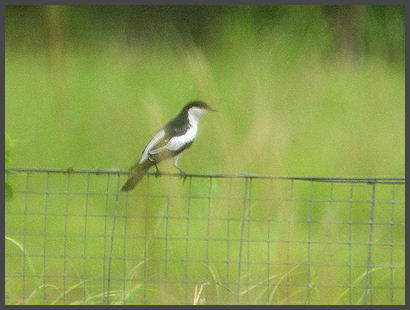
Above: Photo of Male White-winged Triller in breeding plumage.
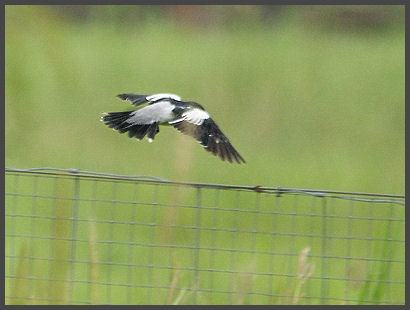
Above: Photo of male White-winged Triller in breeding plumage in flight.
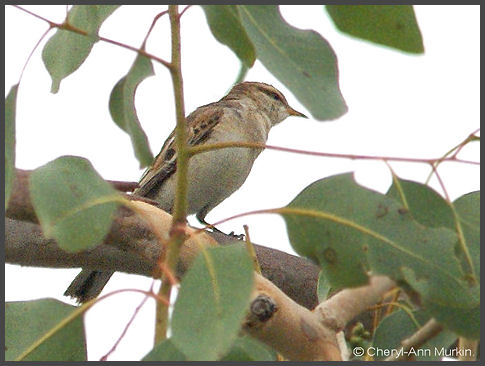
Photos of White-winged Triller - taken at 2:36pm approx. Wednesday June 3, 2015.
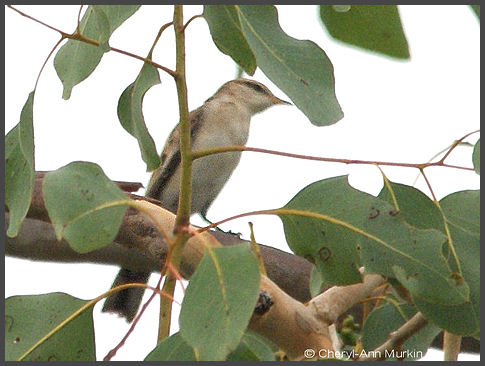
Above photos of Non-breeding/Female/Immature White-winged Triller - Can't quite make out due to poorness of photos.
White-winged Triller fairly high up in Eucalypt near our pond, took these photos not long after the Female Varied Triller flew off into the back yard where this tree is situated. Thought this was a young Varied Triller at first. Most often see both species in the yard at the same time, and also hear both species calling throughout the day.
Please feel free to contact me re: incorrect ID on these or any other photos. With good clear photographs, or close-up bird, these birds are easily recognisable but with poorer photos - not so good!!.
VARIED TRILLER: Lalage leucomela:

Photo above of Female Varied Triller - taken Sunday 7 June, 2015.
Just missed the male who jumped into the black bamboo. Several Varied Trillers feeding on figs and insects with many White-winged Trillers, and others. Very cloudy.
My very first photos taken of a Varied Triller in a Golden Duranta in our front yard, been trying to get a photograph of these for years. Not the best photos, but hopefully I can get some better shots!. These photos were very washed out as I had the exposure compensation + up quite a bit trying to photograph some honeyeaters in deep shade, so had to darken these up quite a bit. Another Varied Triller was calling from over the road which I believe was a male. This female called once which alerted me to her presence which was around 8 metres or so away, quickly got some snaps before she flew off, not changing the settings on the camera in the hope that they would turn out OK or I'd miss out again!!.
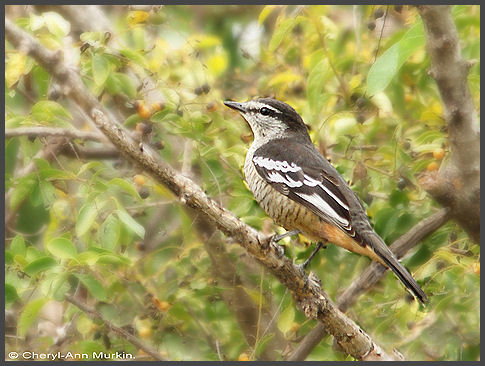
Female Varied Triller - Taken: Wednesday June 3, 2015 at 2:29pm.
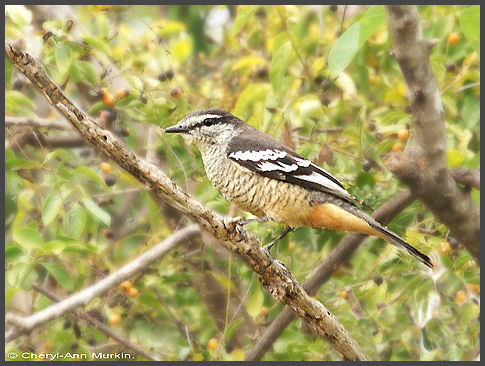
Female Varied Triller: Taken Wednesday June 3, 2015 At 2:29pm approx.
PASSERIFORMES: Family: Pachycephalidae: Whistlers.
RUFOUS WHISTLER: Pachycephala rufiventris:
Adult male Rufous Whistler: Taken: 27 June, 2015:

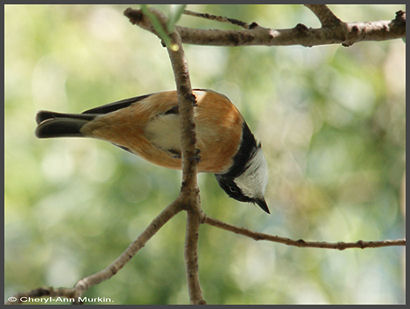
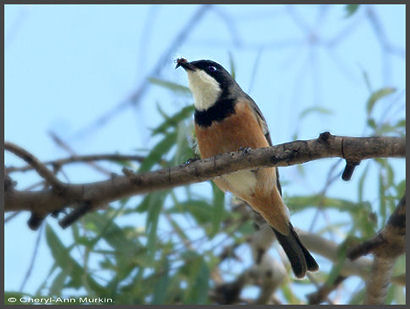
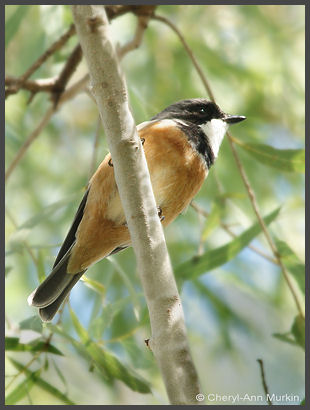
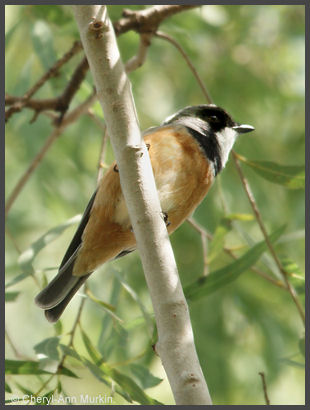
Adult Male Rufous Whistler: Taken: Sunday 21 June, 2015:
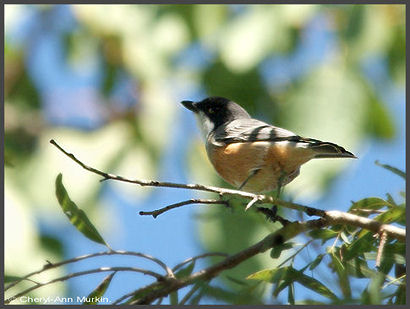
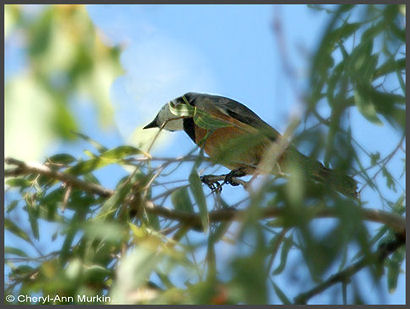
Only photos of Rufous Whistlers I've managed thus far. Hear them more often than see them, and see males more than females as the females seem to be more easier to overlook with their drab colours!.
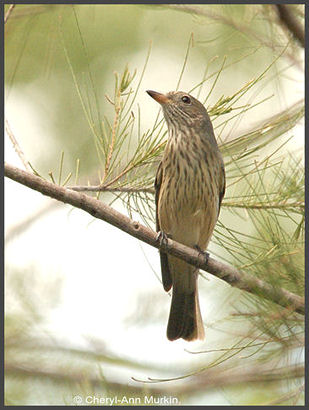 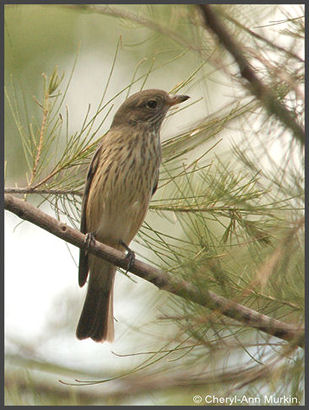
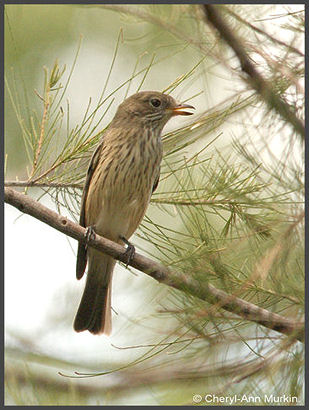 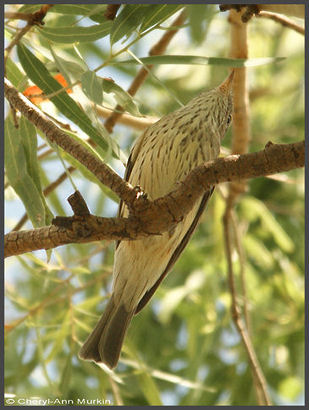

Above photos of female Rufous Whistler which I believe is a younger bird, most likely immature due to the pale colouring of the base of the bill opposed to a mostly black bill in a female adult, (can't see a yellowish coloured gape in these poorer photos so I would probably rule out juvenile) - series of photos taken: 29 April, 2015 - around 12:38:51 through to 12:50:51pm.
 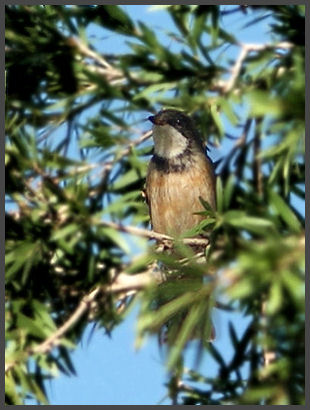
Above photos of male Rufous Whistler just starting to acquire his adult plumage. Note: some streaking still showing on breast and throat and paler rufous breast and belly. More older photos - taken: 7 July, 2013 at 9:44:05 am.
PASSERIFORMES: Family: Colluricinclidae: Shrike-thrushes.
PASSERIFORMES: Family: Oriolidae: Orioles, Figbirds.
OLIVE-BACKED ORIOLE:
Been hearing these guys often. They are often solitary but sometimes feed in the company with figbirds.
AUSTRALASIAN FIGBIRD: Sphecotheres vieilloti.
c-cheryl-annmurkin.jpg) -cheryl-annmurkin.jpg)
Female Australasian Figbird.
 
Male Australasian Figbird - Sphecotheres vieilloti - above and below:- Intergrades between the southern Nominate green figbird subspecies (race) S. vieilloti vieilloti and north-eastern yellow figbird race flaviventris.
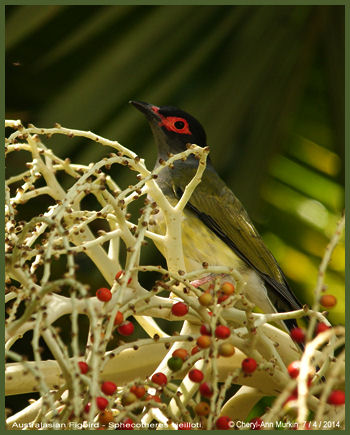 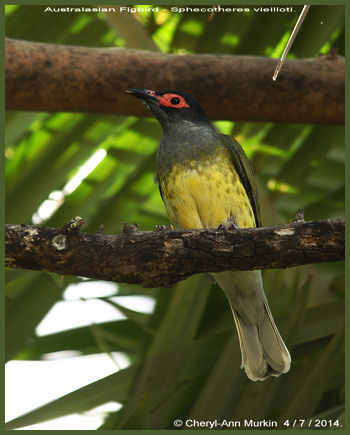
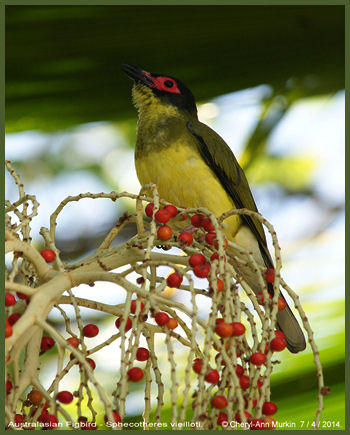 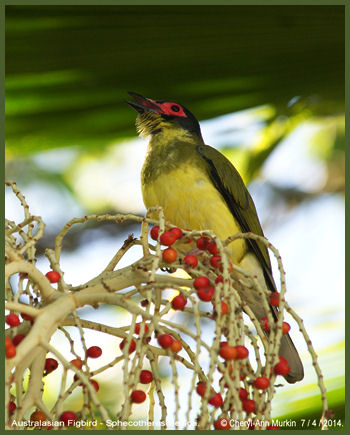
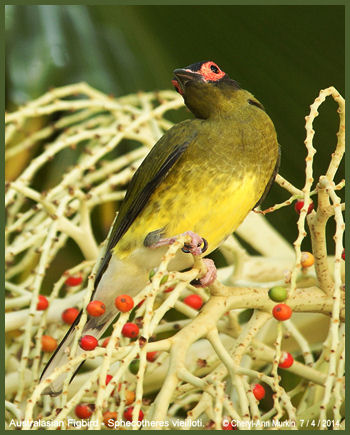 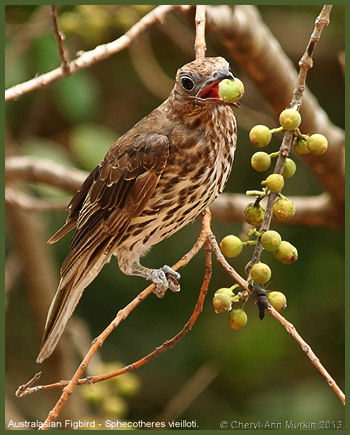
OLIVE-BACKED ORIOLE:
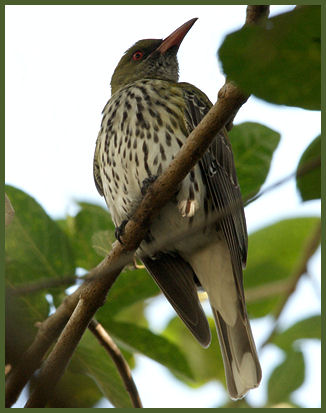 
Above photos of Olive-backed Oriole in Sandpaper Fig.
PASSERIFORMES: Family: Artamidae: Butcherbirds, Australian Magpie, Currawongs and Woodswallows:
White-breasted Woodswallow:
Masked Woodswallow: 8 April, 2015: Mixed flock of mainly Masked Woodswallow & White-browed Woodswallow, joined by a few Fork-tailed Swifts and other Woodswallows fed for around at least an hour. Couldn't get a reliable count but there was lots of them!. Many seemed to be heading in a general easterly to ESE direction. See photos above.
White-browed Woodswallow:
PASSERIFORMES: Family: Dicruridae: Drongos.PASSERIFORMES: Family: Rhipiduridae: Fantails - including Willie-wagtails.
PASSERIFORMES: Family: Corvidae: Ravens, Crows.
PASSERIFORMES: Family: Monarchidae: Magpie-lark, Monarch Flycatchers.
BLACK-FACED MONARCH:
.jpg)
.jpg)

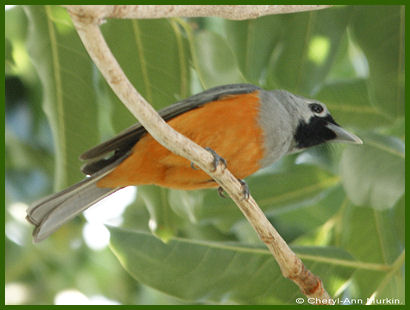
Leaden Flycatcher: Myiagra rubecula. Most likely Subspecies "Yorki" judging by the black lores which are a little difficult to see on this screen as the photos are being processed on a HD screen.
The photos of the female Leaden Flycatcher were my very first photos of a Leaden Flycatcher & were taken 13 January 2013 around 5.00pm under poor lighting conditions in our Casuarinas.
The photos of the male Leaden Flycatcher were taken around midday September 5/6, 2013, again lighting conditions were far from ideal and the sandpaper fig he was perched in was blowing around in strong winds - so lucky to capture him at all. The female was high up in the fig behind.
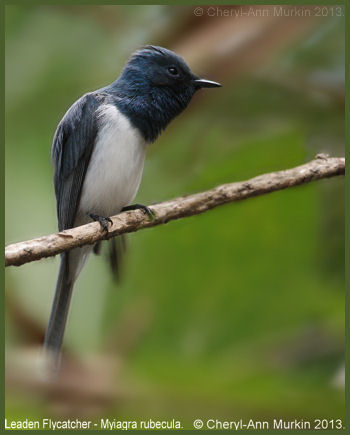 
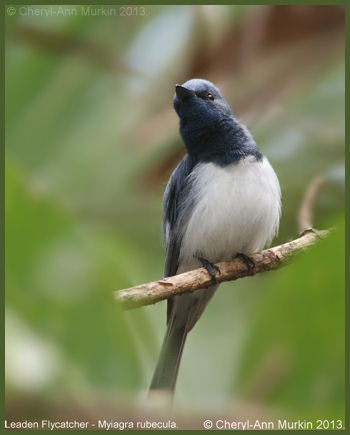 c-cheryl-annmurkin.jpg)
Male Leaden Flycatcher perched in Sandpaper Fig. Female Leaden Flycather in Casuarinas.
Male Leaden Flycatcher perched in Sandpaper Fig.
 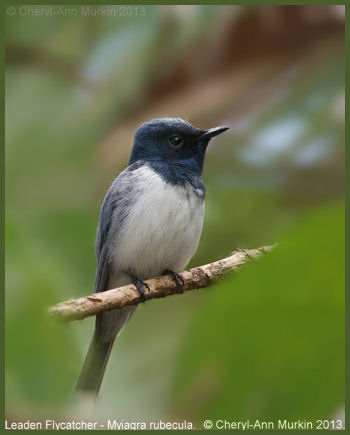  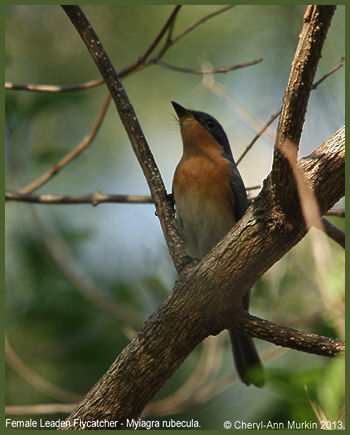 Female Leaden Flycatcher perched in Casuarina. Female Leaden Flycatcher perched in Casuarina.Female Leaden Flycatcher having a rub in Casuarina.
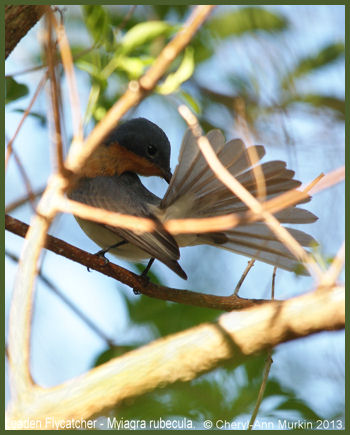 
PASSERIFORMES: Family:
PASSERIFORMES: Family: Nectariniidae: Sunbirds, Flowerpeckers.
MISLETOEBIRD: Dicaeum hirundinaceum:
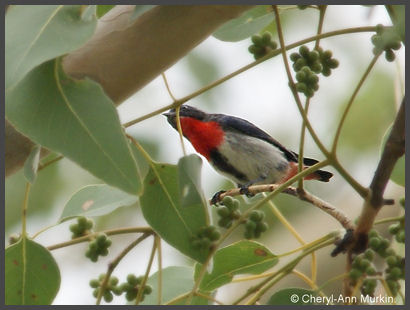
OLIVE-BACKED SUNBIRDS: Nectarinia jugularis.
31 December pair of Sunbirds inspected the nesting site - the manual controller for our roller door on our carport (a red slippery plastic thing hanging from a string). The last inspection of this real estate was in December 2011, not certain whether it was the same pair or not. We were worried that she could abandon the nest with continuous rides back and forwards on the controller when the roller door was opened and closed, but luckily it didn't phase her, nor did our dogs (Collies).
The female got to work in building the nest straight away....but was getting a litle flustered spinning around on the slippery plastic surface...told hubby it needs some tape to stop her from slipping around and he put some tape on resulting in one happy bird!!. Two eggs were laid and both nestlings successfully fledged on the morning of 25 March, 2015. I only witnessed the 2nd baby fledging around 9.35am. Both babies were in the nest late afternoon the day before.
When landing in the sandpaper fig the second fledgling was swooped by a figbird and then set upon by a White-gaped Honeyeater....what a tough start to life!.
The first 2 days after fledging the parent Sunbirds kept the youngsters within approx 6-10 metres from the nest, 3rd day they ventured further to around 15 metres or more encouraged by their parents, flying between mistletoe plants and eucalypts. The favourite spot which they are still using now for feeding is well protected and is within 6-10 metres from the nest and consists of a white Callistemon, Golden Duranta with a flowering mistletoe draped over and between the bushes...Well-timed clutch...with mistletoes flowering.
31 March, 2015 - saw parents and fledglings at 8.30am all doing well.
4 April: Parents still feeding babies. 11th day from fledging. Tails and bills getting longer. Juvenile Sunbirds experienced their first moderately heavy shower of rain at 3-10pm approx.
5 April: Not certain whether parents still feeding babies or not....witnessed a lot of calling to one another but no feeding sounds, although this was just before midday and I hadn't got out to check on them earlier.
Ooops, I've desaturated the colours too much the photos look terrible, wish I would stop doing that!!!.

Fledgling Olive-backed Sunbirds, 4.21pm, 26 March, 2015.
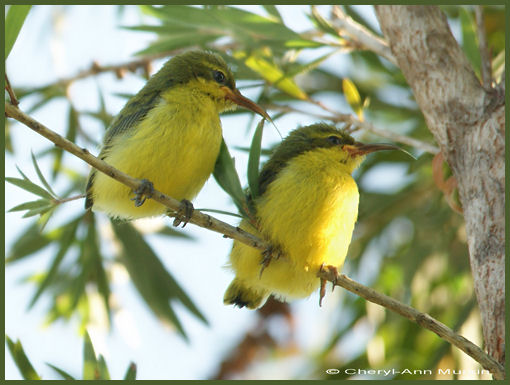
Fledgling Olive-backed Sunbirds with their tongues out.
Poking their tongues at Daddy LOL!.
PASSERIFORMES: Family: Passeridae: Old World Sparrows - including House Sparrow.
PASSERIFORMES: Family: Estrildidae: Finches, Parrotfinches, Munias/Mannikins.
SCALY-BREASTED MANNIKIN (Munia): Lonchura punctulata: (Spice Finch, Nutmeg Finch, etc). Introduced species through the aviary bird trade.
Nesting in our Bismarckia Palm. They also love our Pandanus spp. They share this palm and other nesting sites Pandanus (having turns) with our native Chestnut-breasted Mannikins (Munia). Photos taken around January 16, 2013.
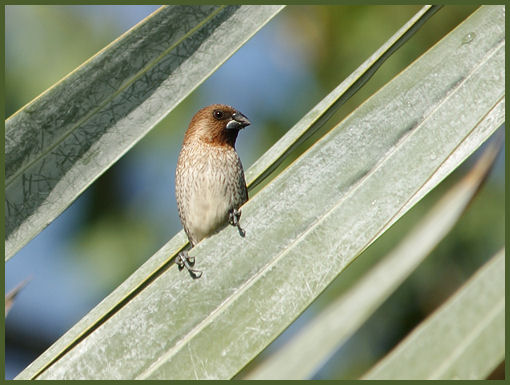
Scaly-breasted Mannikin at nesting site.
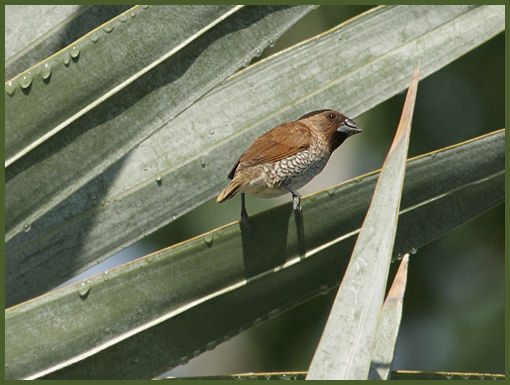
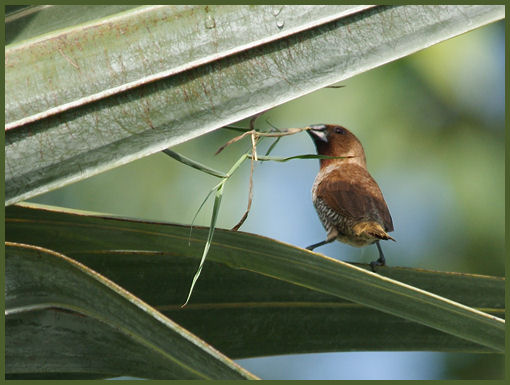
Scaly-breasted Mannikin with nesting material.
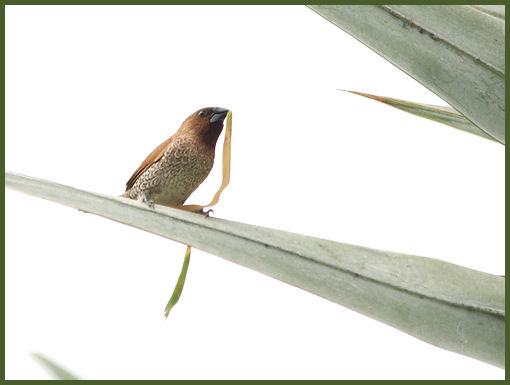
Scaly-breasted Mannikin with nesting material.
|